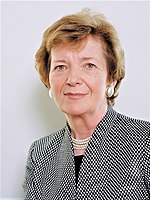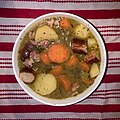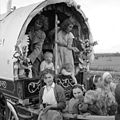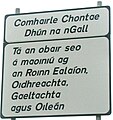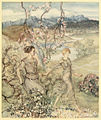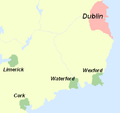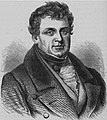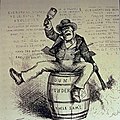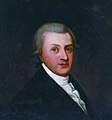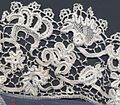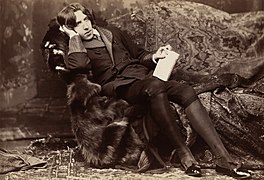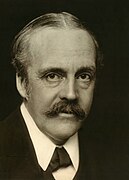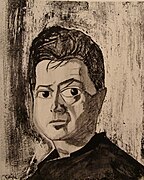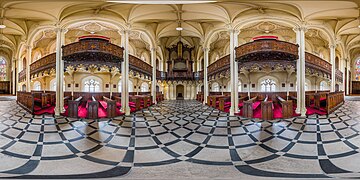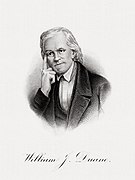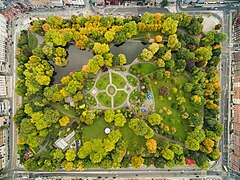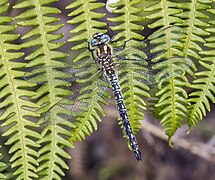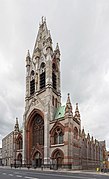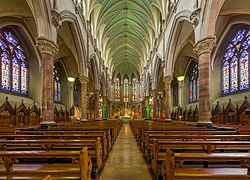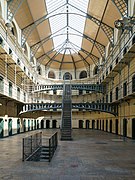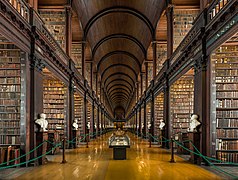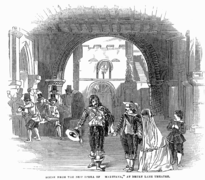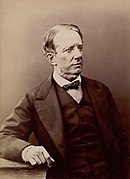|
|
Introduction
| Sister portal: |
|---|
| Northern Ireland |
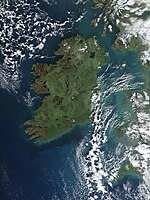
Ireland (/ˈaɪərlənd/ IRE-lənd; Irish: Éire [ˈeːɾʲə] ; Ulster-Scots: Airlann [ˈɑːrlən]) is an island in the North Atlantic Ocean, in north-western Europe. It is separated from Great Britain to its east by the North Channel, the Irish Sea, and St George's Channel. Ireland is the second-largest island of the British Isles, the third-largest in Europe, and the twentieth-largest in the world.
Geopolitically, the island of Ireland is divided between the Republic of Ireland (officially named Ireland), an independent state covering five-sixths of the island, and Northern Ireland, which is part of the United Kingdom. As of 2022, the population of the entire island is just over 7 million, with 5.1 million living in the Republic of Ireland and 1.9 million in Northern Ireland, ranking it the second-most populous island in Europe after Great Britain.
The geography of Ireland comprises relatively low-lying mountains surrounding a central plain, with several navigable rivers extending inland. Its lush vegetation is a product of its mild but changeable climate which is free of extremes in temperature. Much of Ireland was woodland until the end of the Middle Ages. Today, woodland makes up about 10% of the island, compared with a European average of over 33%, with most of it being non-native conifer plantations. The Irish climate is influenced by the Atlantic Ocean and thus very moderate, and winters are milder than expected for such a northerly area, although summers are cooler than those in continental Europe. Rainfall and cloud cover are abundant. (Full article...)
Selected article -
Brú na Bóinne (English: Palace of the Boyne) is an internationally important complex of Neolithic chamber tombs, standing stones, henges and other prehistoric enclosures located in a wide meander of the River Boyne in Ireland. Later, it was used for Iron Age burials. The Normans settled the area in the Middle Ages and in 1690 it was the site of the famous Battle of the Boyne. The site is often referred to as the "Bend of the Boyne", and this is often (incorrectly) taken to be a translation of Brú na Bóinne. It is a World Heritage Site, containing what have been described as the national monuments of Ireland.
The site covers 780ha and contains around 40 passage tombs as well as other prehistoric sites and later features. The majority of the monuments are concentrated on the north side of the river. The most well-known sites within Brú na Bóinne are the impressive passage graves of Newgrange, Knowth and Dowth all famous for their significant collections of megalithic art. Each stands on a ridge within the river bend and two of the tombs, Knowth and Newgrange appear to contain stones re-used from an earlier monument at the site. There is no in situ evidence for earlier activity at the site however save for the spotfinds of flint tools left by Mesolithic hunters. Read more...
Selected biography -
Mary Therese Winifred Robinson (Irish: Máire Mhic Róibín; born 21 May 1944) was the first female President of Ireland, serving from 1990 to 1997, and the United Nations High Commissioner for Human Rights, from 1997 to 2002. She first rose to prominence as an academic, barrister, campaigner and member of the Irish senate (1969–1989). She defeated Fianna Fáil's Brian Lenihan and Fine Gael's Austin Currie in the 1990 presidential election becoming, as an Independent candidate nominated by the Labour Party, the Workers' Party of Ireland and independent senators, the first elected president in the office's history not to have the support of Fianna Fáil.
She is credited by many as having revitalised and liberalised a previously conservative political office. She resigned the presidency four months ahead of the end of her term of office to take up her post in the United Nations. Robinson has been Honorary President of Oxfam International since 2002, she is Chair of the International Institute for Environment and Development (IIED) and is also a founding member and Chair of the Council of Women World Leaders. Robinson is also one of the European members of the controversial Trilateral Commission.
She serves on many boards including the GAVI Fund. Robinson’s newest project is Realizing Rights: the Ethical Globalization Initiative, which promotes equitable trade and development, more humane migration policies and better responses to HIV/AIDS in Africa. The organization also promotes women's leadership and supports capacity building and good governance in developing countries. She is Chancellor of the University of Dublin. Since 2004, she has also been Professor of Practice in International Affairs at Columbia University, where she teaches international human rights. Robinson also visits other colleges and universities where she lectures on human rights.
In 2004, she received Amnesty International's Ambassador of Conscience Award for her work in promoting human rights. Read more...
Topics
General images
Selected picture
Selected city -

Kilkenny (Irish: Cill Chainnigh [ˌciːl̠ʲ ˈxan̠ʲəj], meaning 'church of Cainnech') is a city in County Kilkenny, Ireland. It is located in the South-East Region and in the province of Leinster. It is built on both banks of the River Nore. The 2022 census gave the population of Kilkenny as 27,184, the thirteenth-largest urban center in Ireland.
Kilkenny is a tourist destination, and its environs include historic buildings such as Kilkenny Castle, St Canice's Cathedral and round tower, Rothe House, Shee Alms House, Black Abbey, St. Mary's Cathedral, The Tholsel, St. Francis Abbey, Grace's Castle, and St. John's Priory. Kilkenny is also known for its craft and design workshops, the Watergate Theatre, public gardens and museums. Annual events include Kilkenny Arts Festival, the Cat Laughs comedy festival and music at the Kilkenny Roots Festival. (Full article...)Related portals
Did you know -
- ...that when County Clare was created in 1565 it was moved from Munster to Connacht only to be returned to Munster again in 1602?
- …that the MV Kerlogue, an Irish merchant ship, was attacked by both the Allied and Axis sides during World War II and rescued both sides. They rescued the Wild Rose of Liverpool and they rescued 168 Germans, 164 of who spent the rest of The Emergency interned in the Curragh internment camp?
- ...that the College Historical Society of Trinity College, Dublin is the oldest undergraduate student society in the world?
- ...that to the Romans, Scotia was another name for Hibernia, both meaning Ireland?
Categories

Recognized content
| This is a list of recognized content, updated weekly by JL-Bot (talk · contribs) (typically on Saturdays). There is no need to edit the list yourself. If an article is missing from the list, make sure it is tagged (e.g. {{WikiProject Ireland}}) or categorized correctly and wait for the next update. See WP:RECOG for configuration options. |
Featured articles
 Achtung Baby
Achtung Baby Aldfrith of Northumbria
Aldfrith of Northumbria Battle of Tory Island
Battle of Tory Island Arnold Bax
Arnold Bax Book of Kells
Book of Kells Burke and Hare murders
Burke and Hare murders Richard Cantillon
Richard Cantillon Charles I of England
Charles I of England City of Blinding Lights
City of Blinding Lights Clonmacnoise Crozier
Clonmacnoise Crozier Constantine II of Scotland
Constantine II of Scotland Corp Naomh
Corp Naomh Tom Crean (explorer)
Tom Crean (explorer) Andrew Cunningham, 1st Viscount Cunningham of Hyndhope
Andrew Cunningham, 1st Viscount Cunningham of Hyndhope Drapier's Letters
Drapier's Letters John Early (educator)
John Early (educator) Edward I of England
Edward I of England Edward VII
Edward VII European hare
European hare Five Go Down to the Sea?
Five Go Down to the Sea? Operation Flavius
Operation Flavius Dave Gallaher
Dave Gallaher Geography of Ireland
Geography of Ireland George V
George V Michael Gomez
Michael Gomez Lady Gregory
Lady Gregory Anne Hathaway
Anne Hathaway Head VI
Head VI Honan Chapel
Honan Chapel Brian Horrocks
Brian Horrocks House of Plantagenet
House of Plantagenet 1981 Irish hunger strike
1981 Irish hunger strike Irish nationality law
Irish nationality law James II of England
James II of England James Joyce
James Joyce Loveless (album)
Loveless (album) John Bingham, 7th Earl of Lucan
John Bingham, 7th Earl of Lucan James Whiteside McCay
James Whiteside McCay Bernard A. Maguire
Bernard A. Maguire John Churchill, 1st Duke of Marlborough
John Churchill, 1st Duke of Marlborough Cillian Murphy
Cillian Murphy Nelson's Pillar
Nelson's Pillar James Nesbitt
James Nesbitt Ralph Neville
Ralph Neville No Line on the Horizon
No Line on the Horizon One Tree Hill (song)
One Tree Hill (song) Postage stamps of Ireland
Postage stamps of Ireland Red-billed chough
Red-billed chough Representative peer
Representative peer The Revolution Will Not Be Televised (film)
The Revolution Will Not Be Televised (film) James A. Ryder
James A. Ryder Saint Fin Barre's Cathedral
Saint Fin Barre's Cathedral Ernest Shackleton
Ernest Shackleton George Bernard Shaw
George Bernard Shaw Shergar
Shergar Soiscél Molaisse
Soiscél Molaisse Charles Villiers Stanford
Charles Villiers Stanford John Millington Synge
John Millington Synge Murder of Julia Martha Thomas
Murder of Julia Martha Thomas U2 3D
U2 3D U2
U2 William III of England
William III of England W. B. Yeats
W. B. Yeats Zoo TV Tour
Zoo TV Tour
Featured lists
 International Dublin Literary Award
International Dublin Literary Award Ireland women's cricket team record by opponent
Ireland women's cricket team record by opponent List of international goals scored by Robbie Keane
List of international goals scored by Robbie Keane List of Ireland ODI cricketers
List of Ireland ODI cricketers List of Irish Victoria Cross recipients
List of Irish Victoria Cross recipients List of Six Nations Championship hat-tricks
List of Six Nations Championship hat-tricks List of female cabinet ministers of the Republic of Ireland
List of female cabinet ministers of the Republic of Ireland James Nesbitt filmography
James Nesbitt filmography
Good articles
 1988–1994 British broadcasting voice restrictions
1988–1994 British broadcasting voice restrictions 1998 Tour de France
1998 Tour de France 2001 Irish Masters
2001 Irish Masters 2002 Irish Masters
2002 Irish Masters 2003 All-Ireland Senior Football Championship final
2003 All-Ireland Senior Football Championship final 2011 Irish presidential election
2011 Irish presidential election 2021 Dublin Bay South by-election
2021 Dublin Bay South by-election 2021 Munster abuse case
2021 Munster abuse case Acceptable level of violence
Acceptable level of violence Action of 24 October 1798
Action of 24 October 1798 Ailladie
Ailladie Amlaíb Conung
Amlaíb Conung Pádraig Amond
Pádraig Amond Ascall mac Ragnaill
Ascall mac Ragnaill Astral Weeks
Astral Weeks Baby, Please Don't Go
Baby, Please Don't Go Emilia Baeyertz
Emilia Baeyertz Finn Bálor
Finn Bálor Banagher
Banagher Battle of Glenmama
Battle of Glenmama Becoming Jane
Becoming Jane Paudge Behan
Paudge Behan Beheading game
Beheading game Richard Coote, 1st Earl of Bellomont
Richard Coote, 1st Earl of Bellomont Ben Lugmore
Ben Lugmore Billy Boys
Billy Boys 1993 Bishopsgate bombing
1993 Bishopsgate bombing Bjaðmunjo Mýrjartaksdóttir
Bjaðmunjo Mýrjartaksdóttir Charles Blackader
Charles Blackader Murder of Cameron Blair
Murder of Cameron Blair Ernest Radcliffe Bond
Ernest Radcliffe Bond Charles Boycott
Charles Boycott Brigid's cross
Brigid's cross British and Irish Magnetic Telegraph Company
British and Irish Magnetic Telegraph Company Brodir and Ospak of Man
Brodir and Ospak of Man Pierce Brosnan
Pierce Brosnan Simon Byrne
Simon Byrne Cailleach
Cailleach Peter Canavan
Peter Canavan Carrauntoohil
Carrauntoohil Castles in Great Britain and Ireland
Castles in Great Britain and Ireland Neville Chamberlain (police officer)
Neville Chamberlain (police officer) Jack Charlton
Jack Charlton Cherry Wine (Hozier song)
Cherry Wine (Hozier song) Erskine Childers (author)
Erskine Childers (author) Donough MacCarty, 1st Earl of Clancarty
Donough MacCarty, 1st Earl of Clancarty Marshal Clarke
Marshal Clarke Adam Clayton
Adam Clayton Patrick Cleburne
Patrick Cleburne Barry Cogan (footballer)
Barry Cogan (footballer) The Commitments (film)
The Commitments (film) Sarah Conlon
Sarah Conlon Terry Conroy
Terry Conroy Cork Courthouse, Anglesea Street
Cork Courthouse, Anglesea Street Cornwallis in Ireland
Cornwallis in Ireland Andrea Corr
Andrea Corr Patrick Henry Cronin
Patrick Henry Cronin Adrian Crowley
Adrian Crowley Cú Chulainn
Cú Chulainn John Dacey
John Dacey Hugh Daily
Hugh Daily Dál Riata
Dál Riata Cathy Davey
Cathy Davey Michael Davitt
Michael Davitt Daniel Day-Lewis
Daniel Day-Lewis DMC DeLorean
DMC DeLorean Delorentos
Delorentos Domnall Gerrlámhach
Domnall Gerrlámhach Domnall mac Murchada
Domnall mac Murchada Domnall mac Taidc
Domnall mac Taidc Donegal fiddle tradition
Donegal fiddle tradition Derek Dougan
Derek Dougan Colin Doyle (footballer)
Colin Doyle (footballer) Dracula
Dracula Duke of Marmalade
Duke of Marmalade Dundalk F.C.
Dundalk F.C. Echmarcach mac Ragnaill
Echmarcach mac Ragnaill Hurricane Epsilon (2020)
Hurricane Epsilon (2020) European debt crisis
European debt crisis Eurovision Song Contest 1993
Eurovision Song Contest 1993 Eurovision Song Contest 1994
Eurovision Song Contest 1994 Eurovision Song Contest 1995
Eurovision Song Contest 1995 Eurovision Song Contest 1997
Eurovision Song Contest 1997 French expedition to Ireland (1796)
French expedition to Ireland (1796) Patsy Fagan
Patsy Fagan Keith Fahey
Keith Fahey Tom Farquharson
Tom Farquharson Colin Farrell
Colin Farrell The Favourite
The Favourite Fight Like Apes
Fight Like Apes Finnegans Wake
Finnegans Wake Paddy Finucane
Paddy Finucane Fire and Sword
Fire and Sword Mick Flannery
Mick Flannery Battle of Fontenoy
Battle of Fontenoy Paddy Fox
Paddy Fox Free Derry
Free Derry The Frontline (Irish TV programme)
The Frontline (Irish TV programme) The Funcooker
The Funcooker Galtymore
Galtymore Jim Gannon
Jim Gannon Shay Given
Shay Given Francis Gleeson (priest)
Francis Gleeson (priest) Grey Gowrie
Grey Gowrie Grafton Street
Grafton Street James Graham (British Army soldier)
James Graham (British Army soldier) Grangegorman killings
Grangegorman killings Arthur Guinness
Arthur Guinness Guinness Foreign Extra Stout
Guinness Foreign Extra Stout Lisa Hannigan
Lisa Hannigan Ali Hewson
Ali Hewson Lists of mountains and hills in the British Isles
Lists of mountains and hills in the British Isles Hindu–German Conspiracy
Hindu–German Conspiracy His Band and the Street Choir
His Band and the Street Choir Katherine Hughes (activist)
Katherine Hughes (activist) Ímar mac Arailt
Ímar mac Arailt Ímar
Ímar In the Name of the Grandfather
In the Name of the Grandfather Michael Ingham (footballer)
Michael Ingham (footballer) Ireland cricket team
Ireland cricket team Ireland King of Arms
Ireland King of Arms Ireland at the 2006 Winter Olympics
Ireland at the 2006 Winter Olympics Ireland in the Eurovision Song Contest 2007
Ireland in the Eurovision Song Contest 2007 Ireland in the Eurovision Song Contest 2008
Ireland in the Eurovision Song Contest 2008 Ireland in the Eurovision Song Contest 2019
Ireland in the Eurovision Song Contest 2019 Irish Mercantile Marine during World War II
Irish Mercantile Marine during World War II SS Irish Oak (1919)
SS Irish Oak (1919) Willie Irvine
Willie Irvine Kingdom of the Isles
Kingdom of the Isles Jape (band)
Jape (band) Jif (lemon juice)
Jif (lemon juice) The Joshua Tree
The Joshua Tree Daire Keogh
Daire Keogh Kerry Bog Pony
Kerry Bog Pony Kerry slug
Kerry slug T. E. Lawrence
T. E. Lawrence George Lee (journalist)
George Lee (journalist) Legal career of Mary Robinson
Legal career of Mary Robinson Linfield F.C.
Linfield F.C. Louis Lipsett
Louis Lipsett Live and Dangerous
Live and Dangerous Luggala
Luggala Lurgan
Lurgan Becky Lynch
Becky Lynch Evanna Lynch
Evanna Lynch Phil Lynott
Phil Lynott Matthew Lyon
Matthew Lyon Mac Scelling
Mac Scelling MacGillycuddy's Reeks
MacGillycuddy's Reeks James Macnamara
James Macnamara Mangerton Mountain
Mangerton Mountain Gerald Marescaux
Gerald Marescaux Maze Prison escape
Maze Prison escape Velvet McIntyre
Velvet McIntyre Helen McEntee
Helen McEntee Miami Showband killings
Miami Showband killings Liam Miller
Liam Miller Montpelier Hill
Montpelier Hill Moondance
Moondance Gary Moore
Gary Moore Van Morrison
Van Morrison Mount Brandon
Mount Brandon Mountjoy Prison helicopter escape
Mountjoy Prison helicopter escape Enda Muldoon
Enda Muldoon Larry Mullen Jr.
Larry Mullen Jr. Darren Murphy
Darren Murphy Charles MacCarthy, 1st Viscount Muskerry
Charles MacCarthy, 1st Viscount Muskerry My Bloody Valentine (band)
My Bloody Valentine (band) Lewis Nicola
Lewis Nicola Northern Bank robbery
Northern Bank robbery Joseph B. O'Hagan
Joseph B. O'Hagan O'Connell Street
O'Connell Street Eoghan O'Connell
Eoghan O'Connell Jeremiah O'Connor (priest)
Jeremiah O'Connor (priest) Ronan O'Gara
Ronan O'Gara Maureen O'Hara
Maureen O'Hara Oireachtas Rince na Cruinne
Oireachtas Rince na Cruinne Olaf Guthfrithson
Olaf Guthfrithson Oliver's Army
Oliver's Army Ernie O'Malley
Ernie O'Malley One Direction
One Direction John O'Reily
John O'Reily Denise O'Sullivan
Denise O'Sullivan The Oval (Belfast)
The Oval (Belfast) Pakistani cricket team in Ireland in 2018
Pakistani cricket team in Ireland in 2018 Pan Celtic Festival
Pan Celtic Festival Paramilitary punishment attacks in Northern Ireland
Paramilitary punishment attacks in Northern Ireland Police (Northern Ireland) Act 2000
Police (Northern Ireland) Act 2000 Potato
Potato Ragnall ua Ímair
Ragnall ua Ímair Real Irish Republican Army
Real Irish Republican Army Andy Reid (Irish footballer)
Andy Reid (Irish footballer) Republic of Loose
Republic of Loose Charles Reynolds (cleric)
Charles Reynolds (cleric) Seanad career of Mary Robinson
Seanad career of Mary Robinson Boyle Roche
Boyle Roche Ronin (film)
Ronin (film) 1971 Scottish soldiers' killings
1971 Scottish soldiers' killings Sermons of Jonathan Swift
Sermons of Jonathan Swift Shamrock Rovers F.C.
Shamrock Rovers F.C. Henry Boyle, 1st Earl of Shannon
Henry Boyle, 1st Earl of Shannon Sheamus
Sheamus Cillian Sheridan
Cillian Sheridan Shimna River
Shimna River Sigtrygg Silkbeard
Sigtrygg Silkbeard Sitric Cáech
Sitric Cáech Tom Sloan (footballer, born 1900)
Tom Sloan (footballer, born 1900) Slovak Three
Slovak Three Erasmus Smith
Erasmus Smith Joseph Smith
Joseph Smith Songs of Innocence (U2 album)
Songs of Innocence (U2 album) Stay (Faraway, So Close!)
Stay (Faraway, So Close!) Morleigh Steinberg
Morleigh Steinberg Steorn
Steorn Kenneth Strong
Kenneth Strong Students Harness Aid for the Relief of the Elderly
Students Harness Aid for the Relief of the Elderly John de la Pole, 2nd Duke of Suffolk
John de la Pole, 2nd Duke of Suffolk Sunday Bloody Sunday
Sunday Bloody Sunday The Tale of Mac Da Thó's Pig
The Tale of Mac Da Thó's Pig Tham Nguyen
Tham Nguyen Thin Lizzy
Thin Lizzy E. A. Thompson
E. A. Thompson Timoleague Friary
Timoleague Friary Philip Treacy
Philip Treacy Tupelo Honey
Tupelo Honey Twelve Bens
Twelve Bens U2 360° Tour
U2 360° Tour U2 Live at Red Rocks: Under a Blood Red Sky
U2 Live at Red Rocks: Under a Blood Red Sky U2 concert in Sarajevo
U2 concert in Sarajevo Van Morrison: No Surrender
Van Morrison: No Surrender Van Morrison: Too Late to Stop Now
Van Morrison: Too Late to Stop Now Virgin Atlantic Little Red
Virgin Atlantic Little Red War Tour
War Tour Tom Watson (footballer, born 1900)
Tom Watson (footballer, born 1900) James White (author)
James White (author) Wicklow Way
Wicklow Way Wide Awake in Europe
Wide Awake in Europe Oscar Wilde
Oscar Wilde Mary Woffington
Mary Woffington Zombie (The Cranberries song)
Zombie (The Cranberries song) Zooropa
Zooropa
Did you know? articles
 1st Battalion Royal Irish Rifles in World War I
1st Battalion Royal Irish Rifles in World War I 2TV
2TV 7 Up Christmas on Ice
7 Up Christmas on Ice A8(M) motorway (Northern Ireland)
A8(M) motorway (Northern Ireland) 1831 Londonderry City by-election
1831 Londonderry City by-election 1860 Londonderry City by-election
1860 Londonderry City by-election 1870 Londonderry City by-election
1870 Londonderry City by-election 1872 Londonderry City by-election
1872 Londonderry City by-election 1925 Seanad election
1925 Seanad election 1988–1994 British broadcasting voice restrictions
1988–1994 British broadcasting voice restrictions 2005 ICC Trophy
2005 ICC Trophy 2005 United Kingdom general election in Northern Ireland
2005 United Kingdom general election in Northern Ireland 2008 Ireland floods
2008 Ireland floods 2008 Meteor Awards
2008 Meteor Awards 2009 All-Ireland Senior Camogie Championship
2009 All-Ireland Senior Camogie Championship 2009 All-Ireland Senior Football Championship final
2009 All-Ireland Senior Football Championship final 2009 European Cross Country Championships
2009 European Cross Country Championships 2009 Irish emergency budget
2009 Irish emergency budget 2010 Leinster Senior Football Championship final
2010 Leinster Senior Football Championship final 2010 R238 traffic collision
2010 R238 traffic collision 2010 student protest in Dublin
2010 student protest in Dublin 2011 census of Ireland
2011 census of Ireland 2014 Irish cricket season
2014 Irish cricket season 2015–16 Great Britain and Ireland floods
2015–16 Great Britain and Ireland floods 2016–17 NIFL Premiership
2016–17 NIFL Premiership 2019 FAI Cup final
2019 FAI Cup final 2021 Dublin Bay South by-election
2021 Dublin Bay South by-election Abbey Tavern Singers
Abbey Tavern Singers Abbeyknockmoy
Abbeyknockmoy Acallam na Senórach
Acallam na Senórach Acceptable level of violence
Acceptable level of violence William Agar Adamson
William Agar Adamson Adare Productions
Adare Productions Áed in Macáem Tóinlesc
Áed in Macáem Tóinlesc Welbore Ellis Agar
Welbore Ellis Agar Aghavannagh
Aghavannagh Bunny Ahearne
Bunny Ahearne Aidan Walsh: Master of the Universe
Aidan Walsh: Master of the Universe Aiken Promotions
Aiken Promotions Ailladie
Ailladie Aisling (book series)
Aisling (book series) The All Ireland Talent Show series 2
The All Ireland Talent Show series 2 All Saints GAC
All Saints GAC Richard Allen (abolitionist)
Richard Allen (abolitionist) Alphastates
Alphastates Alternative law in Ireland prior to 1921
Alternative law in Ireland prior to 1921 Amaptocare
Amaptocare Amilie, or the Love Test
Amilie, or the Love Test Amlaíb Conung
Amlaíb Conung Pádraig Amond
Pádraig Amond An Taisce
An Taisce John Andrews (footballer, born 1978)
John Andrews (footballer, born 1978) Anglo Irish Bank hidden loans controversy
Anglo Irish Bank hidden loans controversy James Annesley
James Annesley Annie Larsen affair
Annie Larsen affair Anticipation (advertisement)
Anticipation (advertisement) Aodh Méith
Aodh Méith Apocalypse Clown
Apocalypse Clown Jimmy Archer
Jimmy Archer Alexander Armstrong (Royal Navy officer)
Alexander Armstrong (Royal Navy officer) Desmond Arthur
Desmond Arthur Arthur's Day
Arthur's Day Ascall mac Ragnaill
Ascall mac Ragnaill Baz Ashmawy
Baz Ashmawy Sheree Atcheson
Sheree Atcheson Atlantis (commune)
Atlantis (commune) Aughanduff
Aughanduff Bachelor's Double
Bachelor's Double Emilia Baeyertz
Emilia Baeyertz Robin Bailie
Robin Bailie Henry S. Baird
Henry S. Baird Matthew Baird
Matthew Baird Susan Baker
Susan Baker Anne Elizabeth Ball
Anne Elizabeth Ball Robert Ballagh
Robert Ballagh Ballylough
Ballylough Bambie Thug
Bambie Thug Banagher, County Londonderry
Banagher, County Londonderry Bárid mac Ímair
Bárid mac Ímair Henry Barron (judge)
Henry Barron (judge) Gerald Barry (Irish journalist)
Gerald Barry (Irish journalist) Rosemary Barton (politician)
Rosemary Barton (politician) Battle of Glenmama
Battle of Glenmama Baz's Culture Clash
Baz's Culture Clash Bobby Beasley
Bobby Beasley Charles Beattie
Charles Beattie Brian Behan
Brian Behan Paudge Behan
Paudge Behan Beheading game
Beheading game Sir Alfred Beit, 2nd Baronet
Sir Alfred Beit, 2nd Baronet J. Bowyer Bell
J. Bowyer Bell Bell shrine
Bell shrine Ben Lugmore
Ben Lugmore Bertie (TV series)
Bertie (TV series) Bertiespeak
Bertiespeak Big Two derby
Big Two derby Billy Boys
Billy Boys 1993 Bishopsgate bombing
1993 Bishopsgate bombing Black Abbey
Black Abbey Charles Blackader
Charles Blackader Ephraim Blaine
Ephraim Blaine James Blair (politician)
James Blair (politician) Mary Elizabeth Blake
Mary Elizabeth Blake David Blatherwick (diplomat)
David Blatherwick (diplomat) Blogorrah.com
Blogorrah.com Blood and the Moon
Blood and the Moon Blood of the Irish
Blood of the Irish Bloom Festival
Bloom Festival John Buddle Blyth
John Buddle Blyth Boa Island
Boa Island Ernest Radcliffe Bond
Ernest Radcliffe Bond Book of Common Prayer (1559)
Book of Common Prayer (1559) Book of Common Prayer (1662)
Book of Common Prayer (1662) BorderIrish
BorderIrish Philip Boucher-Hayes
Philip Boucher-Hayes Élie Bouhéreau
Élie Bouhéreau Charles Boycott
Charles Boycott Helen Boyle
Helen Boyle Rory Brady
Rory Brady Brain on Fire (film)
Brain on Fire (film) William Thomas Braithwaite
William Thomas Braithwaite Brasil (mythical island)
Brasil (mythical island) Carol Breen
Carol Breen Breffni Park
Breffni Park Brendan O'Carroll's Hot Milk and Pepper
Brendan O'Carroll's Hot Milk and Pepper Sabina Brennan
Sabina Brennan Brennan's Criterion Bar
Brennan's Criterion Bar Britain Quay
Britain Quay 2017 British & Irish Lions tour to New Zealand
2017 British & Irish Lions tour to New Zealand British Relief Association
British Relief Association British and Irish Magnetic Telegraph Company
British and Irish Magnetic Telegraph Company Malcolm Brodie (journalist)
Malcolm Brodie (journalist) Brodir and Ospak of Man
Brodir and Ospak of Man Broighter Gold
Broighter Gold Hamilton Brown
Hamilton Brown James Brown (Elvis impersonator)
James Brown (Elvis impersonator) Ivor Browne
Ivor Browne SS Brussels
SS Brussels Francis Bryan
Francis Bryan Budget Day
Budget Day Edward Bulfin
Edward Bulfin Lawrence Bulger
Lawrence Bulger Robert Burgess (rugby union)
Robert Burgess (rugby union) Adam Butler (politician)
Adam Butler (politician) Thomas Caffrey
Thomas Caffrey Café Paradiso
Café Paradiso Caha Mountains
Caha Mountains Cissie Cahalan
Cissie Cahalan Disappearance of Philip Cairns
Disappearance of Philip Cairns The Cake Sale (album)
The Cake Sale (album) The Cake Sale
The Cake Sale Paul Callaghan (Gaelic footballer)
Paul Callaghan (Gaelic footballer) Cambrai Homily
Cambrai Homily Camden Crawl
Camden Crawl Camden Fort Meagher
Camden Fort Meagher Noelle Campbell-Sharp
Noelle Campbell-Sharp Mary Cannon
Mary Cannon Richard Cantillon
Richard Cantillon List of carillons of the British Isles
List of carillons of the British Isles James Carlile
James Carlile Winifred Carney
Winifred Carney Patrick Carr (Boston Massacre)
Patrick Carr (Boston Massacre) Carra Castle, Antrim
Carra Castle, Antrim Carrauntoohil
Carrauntoohil James Carroll (captain)
James Carroll (captain) Jim Carroll (journalist)
Jim Carroll (journalist) Jack Carson (cricketer)
Jack Carson (cricketer) Steve Carson
Steve Carson John Keegan Casey
John Keegan Casey Castletownroche
Castletownroche Cathedral Music Trust
Cathedral Music Trust Cathreim Thoirdhealbhaigh
Cathreim Thoirdhealbhaigh Caves of Kesh
Caves of Kesh Celebrity Bainisteoir
Celebrity Bainisteoir Celebrity Bainisteoir season 2
Celebrity Bainisteoir season 2 Celebrity Bainisteoir season 1
Celebrity Bainisteoir season 1 Cellach of Armagh
Cellach of Armagh Celtic brooch
Celtic brooch Central Mental Hospital
Central Mental Hospital Ceol an Ghrá
Ceol an Ghrá Neville Chamberlain (police officer)
Neville Chamberlain (police officer) Sir Thomas Chapman, 7th Baronet
Sir Thomas Chapman, 7th Baronet The Chapters
The Chapters Charity Lords of the Ring
Charity Lords of the Ring Jack Charlton
Jack Charlton Cheslakee
Cheslakee Chestnut Street (book)
Chestnut Street (book) Arthur Chichester, 1st Baron Chichester
Arthur Chichester, 1st Baron Chichester The Chieftains in China
The Chieftains in China Erskine Childers (author)
Erskine Childers (author) Christmas FM
Christmas FM Chronicle of Ireland
Chronicle of Ireland The Circus Animals' Desertion
The Circus Animals' Desertion Callaghan MacCarty, 3rd Earl of Clancarty
Callaghan MacCarty, 3rd Earl of Clancarty Donough MacCarty, 1st Earl of Clancarty
Donough MacCarty, 1st Earl of Clancarty Claregalway Friary
Claregalway Friary Frederick Clarendon
Frederick Clarendon Derry Clarke
Derry Clarke Marshal Clarke
Marshal Clarke Mary Frances Clarke
Mary Frances Clarke Victoria Mary Clarke
Victoria Mary Clarke Peter Cleary
Peter Cleary Patrick Cleburne
Patrick Cleburne Cliftonville Ladies F.C.
Cliftonville Ladies F.C. Climate of Ireland
Climate of Ireland Cloghan Castle (County Cork)
Cloghan Castle (County Cork) Daisy Bannard Cogley
Daisy Bannard Cogley Coirpre mac Néill
Coirpre mac Néill Coleraine Cricket Club
Coleraine Cricket Club Colla mac Báirid
Colla mac Báirid College Street, Dublin
College Street, Dublin Eamonn Collins
Eamonn Collins Patrick Collison
Patrick Collison The Colm and Lucy Show
The Colm and Lucy Show Colman nepos Cracavist
Colman nepos Cracavist Comhdháil na Múinteoirí le Rincí Gaelacha
Comhdháil na Múinteoirí le Rincí Gaelacha Commission on Social Welfare
Commission on Social Welfare Common Travel Area
Common Travel Area The Complex (band)
The Complex (band) Conall Guthbinn
Conall Guthbinn Sarah Conlon
Sarah Conlon Tony Connelly
Tony Connelly Terry Conroy
Terry Conroy Fintan Coogan Jnr
Fintan Coogan Jnr Derek Cooper
Derek Cooper Edward Joshua Cooper
Edward Joshua Cooper Corcomroe Abbey
Corcomroe Abbey Thomas E. Corcoran
Thomas E. Corcoran John Boyle, 15th Earl of Cork
John Boyle, 15th Earl of Cork Cork Opera House
Cork Opera House Cork Public Museum
Cork Public Museum 2007–2008 Cork players' strike
2007–2008 Cork players' strike Corlea Trackway
Corlea Trackway Cormac mac Cuilennáin
Cormac mac Cuilennáin Cornwallis in Ireland
Cornwallis in Ireland Corp Naomh
Corp Naomh Corruption in the Republic of Ireland
Corruption in the Republic of Ireland Martin Corry (politician)
Martin Corry (politician) Patrick Cosgrave
Patrick Cosgrave Declan Costello
Declan Costello Denis Cotter
Denis Cotter Elaine Coughlan
Elaine Coughlan County Fermanagh War Memorial
County Fermanagh War Memorial Margaret Cousins
Margaret Cousins Cove Fort, County Cork
Cove Fort, County Cork John Creedon
John Creedon Samuel Croker-King
Samuel Croker-King Cromwell in Ireland
Cromwell in Ireland Harry Crosbie
Harry Crosbie Brian Crosby (composer)
Brian Crosby (composer) Adrian Crowley
Adrian Crowley Crucifixion plaque
Crucifixion plaque Bill Cullen (businessman)
Bill Cullen (businessman) Gerry Culliton
Gerry Culliton Cumdach
Cumdach Larry Cunningham
Larry Cunningham Paul Cunningham (journalist)
Paul Cunningham (journalist) Andy Cusick
Andy Cusick Aleen Cust
Aleen Cust Cymric (schooner)
Cymric (schooner) Charles D'Arcy
Charles D'Arcy John Dacey
John Dacey Dagán
Dagán Daily Express (Dublin)
Daily Express (Dublin) Hugh Daily
Hugh Daily John Daly (gambler)
John Daly (gambler) P. T. Daly
P. T. Daly Daly's Club
Daly's Club Damo and Ivor
Damo and Ivor David Carradine is a Bounty Hunter Whos Robotic Arm Hates Your Crotch
David Carradine is a Bounty Hunter Whos Robotic Arm Hates Your Crotch Gerald Davis (Irish artist)
Gerald Davis (Irish artist) Michael Davitt
Michael Davitt Hamilton Deane
Hamilton Deane Frank Deasy
Frank Deasy John Deasy (UK MP)
John Deasy (UK MP) Death of Gerry Ryan
Death of Gerry Ryan The Death of Nelson (Maclise painting)
The Death of Nelson (Maclise painting) The Deer's Cry (Pärt)
The Deer's Cry (Pärt) Maude Delap
Maude Delap Deli 613
Deli 613 Derry City F.C. Women
Derry City F.C. Women Attack on Derryard checkpoint
Attack on Derryard checkpoint U Dhammaloka
U Dhammaloka Emily Winifred Dickson
Emily Winifred Dickson Dirty Epics
Dirty Epics Neil Doak
Neil Doak Dóchas Centre
Dóchas Centre Joe Doherty
Joe Doherty Martin Doherty (Irish republican)
Martin Doherty (Irish republican) Michelle Doherty
Michelle Doherty Hazel Dolling
Hazel Dolling Donat Henchy O'Brien
Donat Henchy O'Brien Donegal Corridor
Donegal Corridor Steven Donnelly
Steven Donnelly Roy Dooney
Roy Dooney Beauchamp Doran
Beauchamp Doran Felix Doran (slave trader)
Felix Doran (slave trader) Robert Dorman
Robert Dorman Derek Dougan
Derek Dougan Richard Downes
Richard Downes John G. Downey
John G. Downey Sir John Doyle, 1st Baronet
Sir John Doyle, 1st Baronet Linda Doyle
Linda Doyle Peter Doyle (transit worker)
Peter Doyle (transit worker) Vinnie Doyle
Vinnie Doyle Dracula
Dracula George Drumm
George Drumm Susanna Drury
Susanna Drury Dubarry Park
Dubarry Park Dubgaill and Finngaill
Dubgaill and Finngaill The Dublin Gazette
The Dublin Gazette Dublin Oldschool
Dublin Oldschool Dublin to Gaza
Dublin to Gaza Dublin's Last Supper
Dublin's Last Supper Dublinbikes
Dublinbikes Thomas Duff
Thomas Duff Rita Duffy
Rita Duffy Rose Dugdale
Rose Dugdale Dun Emer Press
Dun Emer Press Dunbrody Country House Hotel
Dunbrody Country House Hotel Kevin Dundon
Kevin Dundon Dungarvan Town Council
Dungarvan Town Council Eliza Hamilton Dunlop
Eliza Hamilton Dunlop Hubert Dunn
Hubert Dunn Randal Plunkett, 21st Baron of Dunsany
Randal Plunkett, 21st Baron of Dunsany Michael Dwyer (journalist)
Michael Dwyer (journalist) John Early (educator)
John Early (educator) Provisional IRA East Tyrone Brigade
Provisional IRA East Tyrone Brigade Elizabeth, Lady Echlin
Elizabeth, Lady Echlin Echoes (Binchy novel)
Echoes (Binchy novel) Economy of Belfast
Economy of Belfast Edmond (1833)
Edmond (1833) Matthew Elderfield
Matthew Elderfield Electric Picnic 2009
Electric Picnic 2009 Electric Picnic 2010
Electric Picnic 2010 Elizabeth Fort
Elizabeth Fort Emerald Warriors RFC
Emerald Warriors RFC Emergency Powers Act 1939
Emergency Powers Act 1939 England's difficulty is Ireland's opportunity
England's difficulty is Ireland's opportunity Rachael English
Rachael English Eunicella verrucosa
Eunicella verrucosa Eurovision Song Contest 1993
Eurovision Song Contest 1993 Eurovision Song Contest 1994
Eurovision Song Contest 1994 Eurovision Song Contest 1997
Eurovision Song Contest 1997 John Everard (MP)
John Everard (MP) Every Song Is a Cry for Love
Every Song Is a Cry for Love Exchequer of Ireland
Exchequer of Ireland Jordan de Exeter
Jordan de Exeter The Expulsion of the Déisi
The Expulsion of the Déisi J. B. Fagan
J. B. Fagan Patsy Fagan
Patsy Fagan Jim Fahy
Jim Fahy Fáilte Towers
Fáilte Towers Fairyhouse Racecourse
Fairyhouse Racecourse Faith of Our Fathers (album)
Faith of Our Fathers (album) Peter Fallon (poet)
Peter Fallon (poet) 2009 Irish budget
2009 Irish budget Pat Fanning
Pat Fanning The Farmer (song)
The Farmer (song) George Farquhar
George Farquhar Tom Farquharson
Tom Farquharson Myra Juliet Farrell
Myra Juliet Farrell Fastnet Lighthouse
Fastnet Lighthouse David Feldman (philatelist)
David Feldman (philatelist) Michael Fenton (politician)
Michael Fenton (politician) Fermanagh County Council
Fermanagh County Council Fermanagh Mallards F.C.
Fermanagh Mallards F.C. Ferney Park
Ferney Park Max Henry Ferrars
Max Henry Ferrars HMS Ferret (1940 shore establishment)
HMS Ferret (1940 shore establishment) Robert Fielding
Robert Fielding Arthur Fields (photographer)
Arthur Fields (photographer) James Field (criminal)
James Field (criminal) Fifty Dead Men Walking
Fifty Dead Men Walking Fight Like Apes and the Mystery of the Golden Medallion
Fight Like Apes and the Mystery of the Golden Medallion Fight Like Apes
Fight Like Apes Peter Finn
Peter Finn Aengus Finucane
Aengus Finucane Fire and Sword
Fire and Sword Robert D. FitzGerald
Robert D. FitzGerald Mabel McConnell Fitzgerald
Mabel McConnell Fitzgerald Noel Fitzpatrick
Noel Fitzpatrick Five Go Down to the Sea?
Five Go Down to the Sea? Flag of Ulster
Flag of Ulster Flag of the Orange Order
Flag of the Orange Order Flaithbertach mac Inmainén
Flaithbertach mac Inmainén Maureen Flavin Sweeney
Maureen Flavin Sweeney Gerald Fleming
Gerald Fleming Floating (Jape song)
Floating (Jape song) Francis Fogarty
Francis Fogarty John H. Foley
John H. Foley Godfrey de Foljambe
Godfrey de Foljambe John Forbes (Royal Navy officer)
John Forbes (Royal Navy officer) David F. Ford
David F. Ford Foreign military units at the state funeral of John F. Kennedy
Foreign military units at the state funeral of John F. Kennedy Fort Davis, County Cork
Fort Davis, County Cork Fort Templebreedy
Fort Templebreedy The Fortress Unvanquishable, Save for Sacnoth
The Fortress Unvanquishable, Save for Sacnoth Walter Foster, 1st Baron Ilkeston
Walter Foster, 1st Baron Ilkeston Paddy Fox
Paddy Fox Frank (film)
Frank (film) Free Education for Everyone
Free Education for Everyone Adrian Freeman
Adrian Freeman From the Sky Down
From the Sky Down The Frontline (Irish TV programme)
The Frontline (Irish TV programme) Fulmar (1868)
Fulmar (1868) Mark Fulton (loyalist)
Mark Fulton (loyalist) Fusiliers' Arch
Fusiliers' Arch GAA 125
GAA 125 Gaelic handball
Gaelic handball Gaelic Journal
Gaelic Journal Maurice Gaffney
Maurice Gaffney Gallagh Man
Gallagh Man Michael Gallagher (postman and prognosticator)
Michael Gallagher (postman and prognosticator) Peter T. Gallagher
Peter T. Gallagher George Monckton-Arundell, 8th Viscount Galway
George Monckton-Arundell, 8th Viscount Galway Garda ar Lár
Garda ar Lár Gerald Gardner (mathematician)
Gerald Gardner (mathematician) The Gay Byrne Show
The Gay Byrne Show Gaze (film festival)
Gaze (film festival) Murder of Shane Geoghegan
Murder of Shane Geoghegan James M. Geraghty
James M. Geraghty Ghost estate
Ghost estate Domhnall Gleeson
Domhnall Gleeson Francis Gleeson (priest)
Francis Gleeson (priest) Gleninsheen gorget
Gleninsheen gorget Global Irish Economic Forum
Global Irish Economic Forum Cathal Goan
Cathal Goan God Save Ireland
God Save Ireland James Godkin
James Godkin Gofraid mac Sitriuc
Gofraid mac Sitriuc Good Friday closure controversy
Good Friday closure controversy Douglas Goodwin
Douglas Goodwin Goose Village
Goose Village Thomas Gisborne Gordon
Thomas Gisborne Gordon Tommie Gorman
Tommie Gorman Grey Gowrie
Grey Gowrie Grafton Street
Grafton Street James Graham (British Army soldier)
James Graham (British Army soldier) Grangegorman killings
Grangegorman killings Gregory Gray
Gregory Gray The Great Escape (Irish TV series)
The Great Escape (Irish TV series) Great Island
Great Island Julius Green
Julius Green The Green Marker Scare
The Green Marker Scare Robert Gregory (RFC officer)
Robert Gregory (RFC officer) Henry Barnes Gresson
Henry Barnes Gresson Greyhound Racing Ireland
Greyhound Racing Ireland Sarah Maria Griffin
Sarah Maria Griffin Guerrilla Gourmet
Guerrilla Gourmet Patrick Guilbaud
Patrick Guilbaud Guinness Black Lager
Guinness Black Lager Richard Haddock
Richard Haddock Hall McKnight
Hall McKnight Lizzie Halliday
Lizzie Halliday George Halpin
George Halpin Ham Sandwich (band)
Ham Sandwich (band) Hanging with Hector
Hanging with Hector William Hankford
William Hankford Hannah (1849 shipwreck)
Hannah (1849 shipwreck) Lisa Hannigan discography
Lisa Hannigan discography Harald Sigtryggsson
Harald Sigtryggsson Neasa Hardiman
Neasa Hardiman Maureen Harding Clark
Maureen Harding Clark Edward Harland
Edward Harland Haughey (TV series)
Haughey (TV series) William Hazlitt (Unitarian minister)
William Hazlitt (Unitarian minister) Head VI
Head VI John Hearne (lawyer)
John Hearne (lawyer) Heat (Irish TV series)
Heat (Irish TV series) Josephine Heffernan
Josephine Heffernan Martin Hehir
Martin Hehir Thomas Herbert (Royal Navy officer)
Thomas Herbert (Royal Navy officer) Tommy Herron
Tommy Herron John Hewitt (footballer)
John Hewitt (footballer) Arthur Hezlet
Arthur Hezlet Mick Higgins
Mick Higgins William Hiseland
William Hiseland History of the Irish in Louisville
History of the Irish in Louisville History of Volkswagen in Ireland
History of Volkswagen in Ireland History of the Irish in Indianapolis
History of the Irish in Indianapolis History of the Irish in Saint Paul
History of the Irish in Saint Paul Robert Lockhart Hobson
Robert Lockhart Hobson Hodges Figgis
Hodges Figgis Hezekiah Holland (minister)
Hezekiah Holland (minister) Holm Park
Holm Park Holy Trinity Church, Cork
Holy Trinity Church, Cork 1880–81 Home Nations rugby union matches
1880–81 Home Nations rugby union matches Home School Hub
Home School Hub William Hone (cricketer)
William Hone (cricketer) Chris Horn (computer scientist)
Chris Horn (computer scientist) Daniel Hough
Daniel Hough House-shaped shrine
House-shaped shrine How Am I Supposed to Kill You If You Have All the Guns?
How Am I Supposed to Kill You If You Have All the Guns? James Scott Howard
James Scott Howard Scott Huey
Scott Huey Katherine Hughes (activist)
Katherine Hughes (activist) Myra Kathleen Hughes
Myra Kathleen Hughes Phil Hughes (footballer)
Phil Hughes (footballer) Gustavus Hume
Gustavus Hume Willie Hume
Willie Hume Hungry Tree
Hungry Tree I Am Not a Serial Killer (film)
I Am Not a Serial Killer (film) Identity and Language (Northern Ireland) Act 2022
Identity and Language (Northern Ireland) Act 2022 Ímar ua Ímair
Ímar ua Ímair Ímar
Ímar In Case of Fire
In Case of Fire In the Name of the Grandfather
In the Name of the Grandfather The Infomatics
The Infomatics Róisín Ingle
Róisín Ingle Eddie Ingram
Eddie Ingram Inishtrahull (1885)
Inishtrahull (1885) Insular crozier
Insular crozier Invasions of the British Isles
Invasions of the British Isles Invisible (U2 song)
Invisible (U2 song) Ireland cricket team
Ireland cricket team Ireland King of Arms
Ireland King of Arms Ireland–South Africa relations
Ireland–South Africa relations Ireland at the 1968 Summer Paralympics
Ireland at the 1968 Summer Paralympics Ireland at the 2016 Summer Olympics
Ireland at the 2016 Summer Olympics Ireland at the Paralympics
Ireland at the Paralympics Ireland in the Eurovision Song Contest 2008
Ireland in the Eurovision Song Contest 2008 Ireland lunar sample displays
Ireland lunar sample displays Ireland's Eye
Ireland's Eye Ireland's Greatest
Ireland's Greatest Írgalach mac Conaing
Írgalach mac Conaing Irische Legende
Irische Legende Irish Bee Conservation Project
Irish Bee Conservation Project 2010 Irish budget
2010 Irish budget Irish Central Committee for the Employment of Women
Irish Central Committee for the Employment of Women Irish Donation of 1676
Irish Donation of 1676 The Irish Famine (book)
The Irish Famine (book) Irish Fright
Irish Fright Irish Landmark Trust
Irish Landmark Trust Irish Legion
Irish Legion SS Irish Pine (1919)
SS Irish Pine (1919) Irish Red and White Setter
Irish Red and White Setter Irish Steel
Irish Steel Irish Uruguayans
Irish Uruguayans SS Irish Willow (1917)
SS Irish Willow (1917) 1981 Irish hunger strike
1981 Irish hunger strike Irish in Omaha, Nebraska
Irish in Omaha, Nebraska Irish nationality law
Irish nationality law Irish of Vincennes
Irish of Vincennes Willie Irvine
Willie Irvine Battle of Islandbridge
Battle of Islandbridge Italian Quarter, Dublin
Italian Quarter, Dublin JFK in Ireland
JFK in Ireland Jack Taylor (TV series)
Jack Taylor (TV series) Jazzy (singer)
Jazzy (singer) Jedward
Jedward Brian Jennings (journalist)
Brian Jennings (journalist) Caitriona Jennings
Caitriona Jennings Jif (lemon juice)
Jif (lemon juice) John 3:7 (sign)
John 3:7 (sign) John O'Donoghue expenses scandal
John O'Donoghue expenses scandal Emer Jones
Emer Jones Theobald Jones
Theobald Jones Theophilus Jones (Royal Navy officer)
Theophilus Jones (Royal Navy officer) Thomas Jones (bishop)
Thomas Jones (bishop) Walter Jones (Irish politician)
Walter Jones (Irish politician) Isobel Joyce
Isobel Joyce Katherine Sophia Kane
Katherine Sophia Kane Robert Kane (chemist)
Robert Kane (chemist) Katherine Lynch's Wonderwomen
Katherine Lynch's Wonderwomen Katherine Lynch's Working Girls
Katherine Lynch's Working Girls Niamh Kavanagh
Niamh Kavanagh Gerald Kean
Gerald Kean Lorraine Keane
Lorraine Keane Arlene Kelly (cricketer)
Arlene Kelly (cricketer) Cathy Kelly
Cathy Kelly Gertrude Kelly
Gertrude Kelly Kelly homestead
Kelly homestead Kentucky Irish American
Kentucky Irish American Kerry bog slides
Kerry bog slides Kidnapping of Sharon Commins and Hilda Kawuki
Kidnapping of Sharon Commins and Hilda Kawuki Kilbroney Park
Kilbroney Park Kildare Poems
Kildare Poems Kildare Street Club
Kildare Street Club Kilmainham Brooch
Kilmainham Brooch Gay Kindersley
Gay Kindersley The Kinetiks
The Kinetiks Margaret King
Margaret King King Oak
King Oak Charles Kingston O'Mahony
Charles Kingston O'Mahony Seán Kinsella
Seán Kinsella Alan Kirby
Alan Kirby Thomas Kirkman
Thomas Kirkman Kiss (Irish magazine)
Kiss (Irish magazine) Knockeen Portal Tomb
Knockeen Portal Tomb Matilda Cullen Knowles
Matilda Cullen Knowles Robert Knox (bishop)
Robert Knox (bishop) L'Ecrivain
L'Ecrivain Peter Lacy
Peter Lacy Lagan Canal
Lagan Canal William Russell Lane-Joynt
William Russell Lane-Joynt Lansdowne Road football riot
Lansdowne Road football riot Lucy de László
Lucy de László The Late Late Show (season 46)
The Late Late Show (season 46) The Late Late Show season 47
The Late Late Show season 47 The Late Late Show season 48
The Late Late Show season 48 The Late Late Show season 49
The Late Late Show season 49 The Late Late Toy Show
The Late Late Toy Show Laureate na nÓg
Laureate na nÓg Hazel Lavery
Hazel Lavery John Law (bishop)
John Law (bishop) Áine Lawlor
Áine Lawlor Thomas Lawlor (bass-baritone)
Thomas Lawlor (bass-baritone) T. E. Lawrence
T. E. Lawrence James Le Jeune
James Le Jeune George Martin Lees
George Martin Lees Eeva Leinonen
Eeva Leinonen Sammy Leslie
Sammy Leslie Gaby Lewis
Gaby Lewis Karlin Lillington
Karlin Lillington Linear (film)
Linear (film) Linn Duachaill
Linn Duachaill Lismore Crozier
Lismore Crozier List of Irish county nicknames
List of Irish county nicknames List of female cabinet ministers of the Republic of Ireland
List of female cabinet ministers of the Republic of Ireland List of female members of the House of Commons of Northern Ireland
List of female members of the House of Commons of Northern Ireland List of hoards in Ireland
List of hoards in Ireland James Little (physician)
James Little (physician) Little White Lie (2008 film)
Little White Lie (2008 film) Dickie Lloyd
Dickie Lloyd Lóegaire mac Néill
Lóegaire mac Néill Londonderry Borough Police
Londonderry Borough Police Bill Long (writer)
Bill Long (writer) Long Distance Swimmer
Long Distance Swimmer James Long (priest)
James Long (priest) William Long (Northern Ireland politician)
William Long (Northern Ireland politician) Loudest Whisper
Loudest Whisper Lough Hyne
Lough Hyne Monica Loughman
Monica Loughman Loy (spade)
Loy (spade) Thomas Clarke Luby
Thomas Clarke Luby The Luck of the Irish (song)
The Luck of the Irish (song) The Lucy Kennedy Show
The Lucy Kennedy Show Lugaid mac Lóegairi
Lugaid mac Lóegairi Luggala
Luggala Thomas Ranken Lyle
Thomas Ranken Lyle William Lyle
William Lyle Denis Lynch
Denis Lynch Katherine Lynch
Katherine Lynch Philomena Lynott
Philomena Lynott Matthew Lyon
Matthew Lyon Lyons Demesne
Lyons Demesne George Lyttleton Rogers
George Lyttleton Rogers Mac Amhlaoibh and Mac Amhalghaidh (Irish septs)
Mac Amhlaoibh and Mac Amhalghaidh (Irish septs) Cathal Mac Coille
Cathal Mac Coille Mac Creiche
Mac Creiche MacCarthy's Bar
MacCarthy's Bar MacGillycuddy's Reeks
MacGillycuddy's Reeks Charles MacCarthy (British Army officer)
Charles MacCarthy (British Army officer) Seán Mac Diarmada
Seán Mac Diarmada Roche MacGeoghegan
Roche MacGeoghegan Pádraig MacKernan
Pádraig MacKernan James Macnamara
James Macnamara Máel Sechnaill mac Máele Ruanaid
Máel Sechnaill mac Máele Ruanaid Battle of Mag Femen
Battle of Mag Femen Magazine Fort
Magazine Fort Chloe Magee
Chloe Magee James Magee (sportsman, born 1872)
James Magee (sportsman, born 1872) Louis Magee
Louis Magee Magnificent (U2 song)
Magnificent (U2 song) Bernard A. Maguire
Bernard A. Maguire Eleanor Maguire
Eleanor Maguire Neven Maguire
Neven Maguire Mahee Castle
Mahee Castle Bríd Mahon
Bríd Mahon James Patrick Mahon
James Patrick Mahon Paddy Mahon
Paddy Mahon Patrick Manogue
Patrick Manogue Eamonn Mansfield
Eamonn Mansfield Manx2 Flight 7100
Manx2 Flight 7100 Gerald Marescaux
Gerald Marescaux The Marian Finucane Show
The Marian Finucane Show Larry Marley
Larry Marley Martyrology of Tallaght
Martyrology of Tallaght Mary Shelley (film)
Mary Shelley (film) Lindsay Mason
Lindsay Mason Thomas Monck Mason
Thomas Monck Mason Montague James Mathew
Montague James Mathew Colin Mawby
Colin Mawby MayKay
MayKay Tibbot na Long Bourke, 1st Viscount Mayo
Tibbot na Long Bourke, 1st Viscount Mayo Maze Prison escape
Maze Prison escape Aonghus McAnally
Aonghus McAnally Liam McCarthy and John D. O'Callaghan
Liam McCarthy and John D. O'Callaghan Niall McCrudden
Niall McCrudden Harry McGee
Harry McGee Charlie McGeever
Charlie McGeever Pat McGeown
Pat McGeown Dylan McGrath
Dylan McGrath Ian McKeever (mountaineer)
Ian McKeever (mountaineer) Charlene McKenna
Charlene McKenna Laurence McKeown
Laurence McKeown Neil McLaughlin
Neil McLaughlin Fionn McLoughlin
Fionn McLoughlin Barney McMahon
Barney McMahon Jackie McMullan
Jackie McMullan Janet McNeill
Janet McNeill John McShain
John McShain Kitty McShane
Kitty McShane Andy "The Bull" McSharry
Andy "The Bull" McSharry Robert McConnell (loyalist)
Robert McConnell (loyalist) Jenny McCudden
Jenny McCudden Vincent McNamara
Vincent McNamara The Meaning of Life (TV series)
The Meaning of Life (TV series) Martin Meehan (Irish republican)
Martin Meehan (Irish republican) Merry Christmas Jakey Boy
Merry Christmas Jakey Boy Met Éireann
Met Éireann Carol Metchette
Carol Metchette Mew Island Lighthouse
Mew Island Lighthouse The Miami Showband
The Miami Showband Midleton College
Midleton College Military Reaction Force
Military Reaction Force Robert Millar (marketer)
Robert Millar (marketer) Milltown (stadium)
Milltown (stadium) Minoru (horse)
Minoru (horse) Mint Productions
Mint Productions Mint (restaurant)
Mint (restaurant) Francis Mitchell
Francis Mitchell Mobhí Clárainech
Mobhí Clárainech Moira Hoey
Moira Hoey Cliodhna Moloney
Cliodhna Moloney Mick Moloney
Mick Moloney Martin Molony
Martin Molony The Monkeys in the Zoo Have More Fun Than Me
The Monkeys in the Zoo Have More Fun Than Me Montgomery Guards
Montgomery Guards Montpelier Hill
Montpelier Hill Mooghaun
Mooghaun Mooney (radio programme)
Mooney (radio programme) Gary Moore
Gary Moore Morning Ireland
Morning Ireland Mouse Morris
Mouse Morris Katie Morrow
Katie Morrow Mount Brandon
Mount Brandon Mount Sandel Mesolithic site
Mount Sandel Mesolithic site Mountjoy Prison helicopter escape
Mountjoy Prison helicopter escape Mourneview Park
Mourneview Park Moylough Belt-Shrine
Moylough Belt-Shrine Muiredach's High Cross
Muiredach's High Cross Gerry Mullan (politician)
Gerry Mullan (politician) Dan Mullane
Dan Mullane Emma Mullin
Emma Mullin Jonathan Mullin
Jonathan Mullin Sean Mulryan
Sean Mulryan Munster Technological University
Munster Technological University Amee-Leigh Murphy Crowe
Amee-Leigh Murphy Crowe John Tuohill Murphy
John Tuohill Murphy Jerome Murphy-O'Connor
Jerome Murphy-O'Connor John Murray (Irish broadcaster)
John Murray (Irish broadcaster) Murder of Raonaid Murray
Murder of Raonaid Murray Paula Murrihy
Paula Murrihy Museum of Literature Ireland
Museum of Literature Ireland The Music Show (Ireland)
The Music Show (Ireland) The Mustard Seed (restaurant)
The Mustard Seed (restaurant) MUZU.TV
MUZU.TV N53 road (Ireland)
N53 road (Ireland) N54 road (Ireland)
N54 road (Ireland) Siege of Namur (1695)
Siege of Namur (1695) Naomh Pádraig GAA (London)
Naomh Pádraig GAA (London) A Nation Once Again
A Nation Once Again National Leprechaun Museum
National Leprechaun Museum National Museum of Ireland – Decorative Arts and History
National Museum of Ireland – Decorative Arts and History National Ploughing Championships
National Ploughing Championships Maurice Neligan
Maurice Neligan Nendrum Monastery
Nendrum Monastery Ness (Irish mythology)
Ness (Irish mythology) Joy Neville
Joy Neville New York Dog
New York Dog Newforge
Newforge Newry City A.F.C.
Newry City A.F.C. Frank Newsam
Frank Newsam Doireann Ní Bhriain
Doireann Ní Bhriain Eimer Ní Mhaoldomhnaigh
Eimer Ní Mhaoldomhnaigh Nighthawks (TV series)
Nighthawks (TV series) SS Noemijulia
SS Noemijulia Linda Nolan
Linda Nolan William Norcott (satirist)
William Norcott (satirist) North/South Inter-Parliamentary Association
North/South Inter-Parliamentary Association North West Liberties of Londonderry
North West Liberties of Londonderry Northern Bank robbery
Northern Bank robbery Christopher Nugent (Medal of Honor)
Christopher Nugent (Medal of Honor) Henry Nugent
Henry Nugent Ryle Nugent
Ryle Nugent William Nugent
William Nugent Joseph Nunan
Joseph Nunan Joseph B. O'Hagan
Joseph B. O'Hagan Jeremiah O'Connor (priest)
Jeremiah O'Connor (priest) Michael O'Doherty (publisher)
Michael O'Doherty (publisher) Majella O'Donnell
Majella O'Donnell Daithí Ó Drónaí
Daithí Ó Drónaí May O'Flaherty
May O'Flaherty Purcell O'Gorman
Purcell O'Gorman Edward O'Grady
Edward O'Grady Maureen O'Hara
Maureen O'Hara Iarla Ó Lionáird
Iarla Ó Lionáird Ruth O'Reilly
Ruth O'Reilly Alice O'Sullivan
Alice O'Sullivan Louise O'Sullivan (businesswoman)
Louise O'Sullivan (businesswoman) Enda Oates
Enda Oates Ralph Smith O'bré
Ralph Smith O'bré Breandán Ó Buachalla
Breandán Ó Buachalla Occupied Territories Bill
Occupied Territories Bill Derek O'Connor (journalist)
Derek O'Connor (journalist) Fred O'Donovan (theatre producer)
Fred O'Donovan (theatre producer) Pól Ó Foighil
Pól Ó Foighil Nollaig Ó Gadhra
Nollaig Ó Gadhra Marianna O'Gallagher
Marianna O'Gallagher Sylvester O'Halloran
Sylvester O'Halloran Oireachtas Rince na Cruinne
Oireachtas Rince na Cruinne Oistin mac Amlaíb
Oistin mac Amlaíb Con O'Kelly
Con O'Kelly Olaf Guthfrithson
Olaf Guthfrithson Ólchobar mac Cináeda
Ólchobar mac Cináeda Clare O'Leary
Clare O'Leary Padraig O'Malley
Padraig O'Malley T. J. O'Malley
T. J. O'Malley On the Street Where You Live (TV series)
On the Street Where You Live (TV series) On being asked for a War Poem
On being asked for a War Poem One to One (TV series)
One to One (TV series) Orders, decorations, and medals of the Republic of Ireland
Orders, decorations, and medals of the Republic of Ireland Ordinary referendum
Ordinary referendum John O'Reily
John O'Reily Evelyn O'Rourke
Evelyn O'Rourke Joseph Cornelius O'Rourke
Joseph Cornelius O'Rourke Orton Plantation
Orton Plantation Oscar Wilde Memorial Sculpture
Oscar Wilde Memorial Sculpture Beverley O'Sullivan
Beverley O'Sullivan The Oval (Belfast)
The Oval (Belfast) Oxegen 2010
Oxegen 2010 Lanre Oyebanjo
Lanre Oyebanjo PSNI GAA
PSNI GAA William Pain
William Pain Pan Celtic Festival
Pan Celtic Festival Paramilitary punishment attacks in Northern Ireland
Paramilitary punishment attacks in Northern Ireland John Parker (bishop)
John Parker (bishop) Party Processions Act 1850
Party Processions Act 1850 Joseph Peacocke (archbishop of Dublin)
Joseph Peacocke (archbishop of Dublin) Lindsay Peat
Lindsay Peat Kathleen Pelham Burn
Kathleen Pelham Burn Permanent North American Gaeltacht
Permanent North American Gaeltacht Alice Perry
Alice Perry Oscar C. Pfaus
Oscar C. Pfaus Michael Phelan (billiards player)
Michael Phelan (billiards player) Phil Lynott (song)
Phil Lynott (song) Walter Alison Phillips
Walter Alison Phillips William Piers (constable)
William Piers (constable) Pigs in blankets
Pigs in blankets Pirate radio in Ireland
Pirate radio in Ireland George Oliver Plunkett
George Oliver Plunkett Peg Plunkett
Peg Plunkett River Poddle
River Poddle Police (Northern Ireland) Act 2000
Police (Northern Ireland) Act 2000 Polish minority in Ireland
Polish minority in Ireland Politics (poem)
Politics (poem) Mark Pollock
Mark Pollock Porcupine Abyssal Plain
Porcupine Abyssal Plain Post-2008 Irish banking crisis
Post-2008 Irish banking crisis Post-2008 Irish economic downturn
Post-2008 Irish economic downturn Postmasters General of Ireland
Postmasters General of Ireland Sir George Power, 7th Baronet
Sir George Power, 7th Baronet Prawo Jazdy (alleged criminal)
Prawo Jazdy (alleged criminal) A Prayer for My Daughter
A Prayer for My Daughter The Pressure Cooker
The Pressure Cooker Protestant Coalition
Protestant Coalition Pure Mule
Pure Mule Sanita Pušpure
Sanita Pušpure Mick Pyro
Mick Pyro Seán Quigley
Seán Quigley Bradley Quinn
Bradley Quinn Pat Quinn (businessman)
Pat Quinn (businessman) R319 road (Ireland)
R319 road (Ireland) R565 road (Ireland)
R565 road (Ireland) R.S.A.G.
R.S.A.G. RCSI-Bahrain
RCSI-Bahrain RTÉ Does Comic Relief
RTÉ Does Comic Relief Ragnall ua Ímair
Ragnall ua Ímair The Raw Sessions
The Raw Sessions Peter Rawlinson, Baron Rawlinson of Ewell
Peter Rawlinson, Baron Rawlinson of Ewell Recumbent stone circle
Recumbent stone circle The Red and the Green
The Red and the Green Reek Sunday
Reek Sunday William Reeves (bishop)
William Reeves (bishop) Reginald's Tower
Reginald's Tower Donal Reid
Donal Reid Paddy Reid
Paddy Reid Gabrielle Reidy
Gabrielle Reidy Republic of Loose
Republic of Loose Restaurant Patrick Guilbaud
Restaurant Patrick Guilbaud Charles Reynolds (cleric)
Charles Reynolds (cleric) Solomon Richards (surgeon)
Solomon Richards (surgeon) River Laune Crozier
River Laune Crozier Road Records
Road Records The Road to Croker
The Road to Croker Olivia Robertson
Olivia Robertson Alexander Robinson
Alexander Robinson Paschal Robinson
Paschal Robinson Michelle Rocca
Michelle Rocca Andrea Roche
Andrea Roche Boyle Roche
Boyle Roche Tiger Roche
Tiger Roche Kevin Rockett
Kevin Rockett Patsy Dan Rodgers
Patsy Dan Rodgers Emma Rogan
Emma Rogan James Edward Rogers
James Edward Rogers Joseph Rogers (pioneer)
Joseph Rogers (pioneer) Cusack Patrick Roney
Cusack Patrick Roney Ronin (film)
Ronin (film) Sally Rooney
Sally Rooney James Rorke
James Rorke Roscrea Brooch
Roscrea Brooch Ross Errilly Friary
Ross Errilly Friary Death of Brian Rossiter
Death of Brian Rossiter Rostellan
Rostellan Richard Rothwell (painter)
Richard Rothwell (painter) Josias Rowley
Josias Rowley Royal Hibernian Hotel
Royal Hibernian Hotel Royal Irish Yacht Club
Royal Irish Yacht Club Royal sites of Ireland
Royal sites of Ireland Dave Rudden
Dave Rudden Rugby Players Ireland
Rugby Players Ireland Rule 42
Rule 42 John Ryan (publisher)
John Ryan (publisher) Mary Ryan (academic)
Mary Ryan (academic) Una M. Ryan
Una M. Ryan James A. Ryder
James A. Ryder John Rutherford Ryley
John Rutherford Ryley James Sadleir
James Sadleir SailRail
SailRail St. Assam's Church
St. Assam's Church St Johnston railway station
St Johnston railway station St. Jude storm
St. Jude storm St. Luke's Hospital, Rathgar
St. Luke's Hospital, Rathgar St. Mary's Abbey, Trim
St. Mary's Abbey, Trim St Mary's Cathedral, Tuam
St Mary's Cathedral, Tuam Tommy Sands (Irish singer)
Tommy Sands (Irish singer) Dominick Sarsfield, 1st Viscount Sarsfield
Dominick Sarsfield, 1st Viscount Sarsfield Margaret Saurin
Margaret Saurin Scissor Sisters (convicted killers)
Scissor Sisters (convicted killers) Sea Sew
Sea Sew Seal Rescue Ireland
Seal Rescue Ireland Season of the Sparks
Season of the Sparks Kevin Seaward
Kevin Seaward Senator George Mitchell Peace Bridge
Senator George Mitchell Peace Bridge Serglige Con Culainn
Serglige Con Culainn Lydia Shackleton
Lydia Shackleton Shamrock Warriors RFC
Shamrock Warriors RFC Shandon Castle, Cork
Shandon Castle, Cork Shandon Street
Shandon Street Sharon Shannon
Sharon Shannon Barry Shaw (barrister)
Barry Shaw (barrister) Laurence Sheil
Laurence Sheil Sinéad Sheppard
Sinéad Sheppard Cillian Sheridan
Cillian Sheridan Kirsten Sheridan
Kirsten Sheridan Niall Sheridan
Niall Sheridan Muzamil Sherzad
Muzamil Sherzad Shoot to Kill (1990 film)
Shoot to Kill (1990 film) Gary Shore
Gary Shore The Showgrounds (Newry)
The Showgrounds (Newry) Shrewsbury Road
Shrewsbury Road Shrine of Miosach
Shrine of Miosach Shrine of Saint Lachtin's Arm
Shrine of Saint Lachtin's Arm Sichfrith Jarl
Sichfrith Jarl Nikki Sievwright
Nikki Sievwright Sigtrygg Silkbeard
Sigtrygg Silkbeard Silver Wedding (novel)
Silver Wedding (novel) Single-Handed (TV series)
Single-Handed (TV series) Sinn Féin Funds case
Sinn Féin Funds case Sir John Rogerson's Quay
Sir John Rogerson's Quay Sitric Cáech
Sitric Cáech Sitriuc mac Ímair
Sitriuc mac Ímair James John Skinner
James John Skinner Skyfest
Skyfest Slieve Gallion
Slieve Gallion Slovak Police training explosives incident
Slovak Police training explosives incident Bernard Smith (abbot)
Bernard Smith (abbot) Robertson Smyth
Robertson Smyth Soiscél Molaisse
Soiscél Molaisse Some Surprise
Some Surprise Charles Spalding
Charles Spalding Gusty Spence
Gusty Spence Robert Spence (bishop)
Robert Spence (bishop) Spider (musician)
Spider (musician) Spit Bank Lighthouse
Spit Bank Lighthouse Alleyne FitzHerbert, 1st Baron St Helens
Alleyne FitzHerbert, 1st Baron St Helens St. Patrick's blue
St. Patrick's blue Stangmore Park
Stangmore Park Theobald Stapleton
Theobald Stapleton Stars on Sunday (newspaper)
Stars on Sunday (newspaper) Morleigh Steinberg
Morleigh Steinberg Stellar (magazine)
Stellar (magazine) HSC Stena Voyager
HSC Stena Voyager Enno Stephan
Enno Stephan Jake Stevens
Jake Stevens Alex Stevenson
Alex Stevenson Albert Stewart (rugby union)
Albert Stewart (rugby union) A. T. Q. Stewart
A. T. Q. Stewart Charles Stewart (Royal Navy officer)
Charles Stewart (Royal Navy officer) Stitches (2012 film)
Stitches (2012 film) Florence Stoney
Florence Stoney Stradbally Hall
Stradbally Hall Battle of Strangford Lough
Battle of Strangford Lough Kenneth Strong
Kenneth Strong John de la Pole, 2nd Duke of Suffolk
John de la Pole, 2nd Duke of Suffolk Jane Suiter
Jane Suiter Mike Sullivan (Wyoming politician)
Mike Sullivan (Wyoming politician) Morris Sullivan
Morris Sullivan Sleeper Sullivan
Sleeper Sullivan David Sullivan (labor leader)
David Sullivan (labor leader) Sunday Bloody Sunday (John Lennon and Yoko Ono song)
Sunday Bloody Sunday (John Lennon and Yoko Ono song) Sunday Observance Act 1695
Sunday Observance Act 1695 Supreme Court of Ireland
Supreme Court of Ireland Fergie Sutherland
Fergie Sutherland Susan Sweney
Susan Sweney Edward Hutchinson Synge
Edward Hutchinson Synge TV Now
TV Now Tailors' Hall
Tailors' Hall Milo Talbot (British Army officer)
Milo Talbot (British Army officer) The Tale of Mac Da Thó's Pig
The Tale of Mac Da Thó's Pig Tap On Wood
Tap On Wood William Desmond Taylor
William Desmond Taylor Technological University Dublin
Technological University Dublin Emma Teeling
Emma Teeling John Teeling
John Teeling Teens in the Wild
Teens in the Wild Temple Cronan
Temple Cronan John K. Tener
John K. Tener That's Just the Way It Is
That's Just the Way It Is The Church of Jesus Christ of Latter-day Saints in Ireland
The Church of Jesus Christ of Latter-day Saints in Ireland The Liffey Swim
The Liffey Swim Thema International Fund
Thema International Fund There's No One as Irish as Barack O'Bama
There's No One as Irish as Barack O'Bama This Is Nightlive
This Is Nightlive Murder of Julia Martha Thomas
Murder of Julia Martha Thomas Sam Thompson (playwright)
Sam Thompson (playwright) Kevin Thornton (chef)
Kevin Thornton (chef) Thornton's Restaurant
Thornton's Restaurant Henry Tibbs
Henry Tibbs David Tidmarsh
David Tidmarsh Titanic Belfast
Titanic Belfast Titanic Memorial, Belfast
Titanic Memorial, Belfast Tyler Toland
Tyler Toland Tonight with Craig Doyle
Tonight with Craig Doyle Tourism in the Republic of Ireland
Tourism in the Republic of Ireland Robert Traill (Irish clergyman)
Robert Traill (Irish clergyman) Transport in Belfast
Transport in Belfast Philip Treacy
Philip Treacy The Tubridy Show
The Tubridy Show John Tuigg
John Tuigg Tully Lough Cross
Tully Lough Cross Francis Tumblety
Francis Tumblety TV Now Awards
TV Now Awards Twelve Bens
Twelve Bens Two Working Men
Two Working Men Mathilda Twomey
Mathilda Twomey U2 360° Tour
U2 360° Tour U2 by U2
U2 by U2 U2 concert in Sarajevo
U2 concert in Sarajevo German submarine U-607
German submarine U-607 UVF Mid-Ulster Brigade
UVF Mid-Ulster Brigade Toirdelbach Ua Briain
Toirdelbach Ua Briain Maelsuthan Ua Cerbhail
Maelsuthan Ua Cerbhail Áed Ua Crimthainn
Áed Ua Crimthainn Flaithbertach Ua Néill
Flaithbertach Ua Néill Unhappy the Land
Unhappy the Land Unplayed Piano
Unplayed Piano VIP (magazine)
VIP (magazine) Van Morrison: No Surrender
Van Morrison: No Surrender Van Morrison: Too Late to Stop Now
Van Morrison: Too Late to Stop Now Vernon Mount
Vernon Mount Victoria and Shane Grow Their Own
Victoria and Shane Grow Their Own Villagers (band)
Villagers (band) Virgin Atlantic Little Red
Virgin Atlantic Little Red The Voice (Eimear Quinn song)
The Voice (Eimear Quinn song) Dolway Walkington
Dolway Walkington Paul Wallace (rugby union)
Paul Wallace (rugby union) Dearbhla Walsh
Dearbhla Walsh Gavin Walsh
Gavin Walsh William Walsh (bishop of Dover)
William Walsh (bishop of Dover) John Ward (prophet)
John Ward (prophet) Mary Ward (suffragist)
Mary Ward (suffragist) Waterford Airport
Waterford Airport André Watson
André Watson Kylie Watson (British Army soldier)
Kylie Watson (British Army soldier) Wingfield W. Watson
Wingfield W. Watson John Anderson, 1st Viscount Waverley
John Anderson, 1st Viscount Waverley The Week in Politics
The Week in Politics John Weir (loyalist)
John Weir (loyalist) Wells in the Irish Dindsenchas
Wells in the Irish Dindsenchas Werewolves of Ossory
Werewolves of Ossory West Jewellers
West Jewellers Western Railway Corridor
Western Railway Corridor Thomas Maloney Westgård
Thomas Maloney Westgård Daniel Whelan
Daniel Whelan Patrick J. Whelan
Patrick J. Whelan Whistleblower (Irish TV series)
Whistleblower (Irish TV series) White Park cattle
White Park cattle Norman Whitten
Norman Whitten Audrey Whitty
Audrey Whitty Wicklow Mountains
Wicklow Mountains Wicklow Way
Wicklow Way Wide Awake in Europe
Wide Awake in Europe Roger Wilbraham
Roger Wilbraham Wild Decembers (TV series)
Wild Decembers (TV series) Willie Wilde
Willie Wilde William Trench, 5th Earl of Clancarty
William Trench, 5th Earl of Clancarty Juanita Wilson
Juanita Wilson Mary Wilson (broadcaster)
Mary Wilson (broadcaster) Frank Winder
Frank Winder Windmill Lane Studios
Windmill Lane Studios Gustav Wilhelm Wolff
Gustav Wilhelm Wolff Tommy Wood (International Brigades)
Tommy Wood (International Brigades) Philip Woodroffe
Philip Woodroffe Wrens of the Curragh
Wrens of the Curragh Charles Theodore Hagberg Wright
Charles Theodore Hagberg Wright Warren Richard Colvin Wynne
Warren Richard Colvin Wynne Lily Yeats
Lily Yeats Yellow Sam betting coup
Yellow Sam betting coup You're a Star series 5
You're a Star series 5 Craig Young (cricketer)
Craig Young (cricketer) Sophie von Maltzan
Sophie von Maltzan
Featured pictures
-
A Wilde time 3
-
Arthur-James-Balfour-1st-Earl-of-Balfour
-
Bacon by Gray 257
-
Chapel Royal 360x180, Dublin Castle, Dublin, Ireland - Diliff
-
DUANE, William J-Treasury (BEP engraved portrait)
-
Dingle peninsula panorama crop
-
Dublin Stephen's Green-44 edit
-
Enoch Powell 6 Allan Warren
-
Francisco Goya - Portrait of the Duke of Wellington
-
Hairy dragonfly (Brachytron pratense) male Burren
-
Irish WWI poster - Is Your Home Worth Fighting For? - Hely's Limited, Litho, Dublin
-
John's Lane Church Exterior, Dublin, Ireland - Diliff
-
John's Lane Church Interior 1, Dublin, Ireland - Diliff
-
Kilmainham Gaol Main Hall 2016-06-03
-
Long Room Interior, Trinity College Dublin, Ireland - Diliff
-
Maritana - Nov 22 1845 Illustrated London News
-
Michael William Balfe - Atelier Nadar
-
Mrs. Pauline Adams 147002v
-
Sir Anthony Van Dyck - Charles I (1600-49) - Google Art Project
-
Sir Arthur Wellesley, 1st Duke of Wellington
-
The harbour in Kingstown, Co. Dublin, Ireland, in about 1895 - Option 2
Featured portals
In the News articles
 2008–2009 Volvo Ocean Race
2008–2009 Volvo Ocean Race 2009 All-Ireland Senior Hurling Championship final
2009 All-Ireland Senior Hurling Championship final 2010 All-Ireland Senior Football Championship final
2010 All-Ireland Senior Football Championship final 2010 United Kingdom general election in Northern Ireland
2010 United Kingdom general election in Northern Ireland 2011 All-Ireland Senior Football Championship final
2011 All-Ireland Senior Football Championship final 2011 Irish presidential election
2011 Irish presidential election 2012 All-Ireland Senior Football Championship final
2012 All-Ireland Senior Football Championship final 2012 All-Ireland Senior Hurling Championship final
2012 All-Ireland Senior Hurling Championship final 2013 All-Ireland Senior Football Championship final
2013 All-Ireland Senior Football Championship final 2013 horse meat scandal
2013 horse meat scandal 2016 All-Ireland Senior Football Championship final
2016 All-Ireland Senior Football Championship final 2016 Irish government formation
2016 Irish government formation 2017 All-Ireland Senior Football Championship final
2017 All-Ireland Senior Football Championship final 2017 Northern Ireland Assembly election
2017 Northern Ireland Assembly election 2018 All-Ireland Senior Football Championship
2018 All-Ireland Senior Football Championship 2018 All-Ireland Senior Football Championship final
2018 All-Ireland Senior Football Championship final 2019 All-Ireland Senior Football Championship final
2019 All-Ireland Senior Football Championship final 2021 All-Ireland Senior Football Championship final
2021 All-Ireland Senior Football Championship final 2022 Northern Ireland Assembly election
2022 Northern Ireland Assembly election Abortion in the Republic of Ireland
Abortion in the Republic of Ireland Allergan
Allergan Anglo Irish Bank hidden loans controversy
Anglo Irish Bank hidden loans controversy 2009 Bank of Ireland robbery
2009 Bank of Ireland robbery John Banville
John Banville Glenn Barr
Glenn Barr Eileen Battersby
Eileen Battersby Niamh Bhreathnach
Niamh Bhreathnach Charlie Bird
Charlie Bird May Blood, Baroness Blood
May Blood, Baroness Blood Bloody Sunday (1972)
Bloody Sunday (1972) Bobs Worth
Bobs Worth Bon Secours Mother and Baby Home
Bon Secours Mother and Baby Home Craig Breen
Craig Breen Brian Cowen nude portraits controversy
Brian Cowen nude portraits controversy 2017 British & Irish Lions tour to New Zealand
2017 British & Irish Lions tour to New Zealand 2009 Great Britain and Ireland floods
2009 Great Britain and Ireland floods James Brokenshire
James Brokenshire Brucellosis
Brucellosis Pat Buckley (priest)
Pat Buckley (priest) Joe Burke (accordionist)
Joe Burke (accordionist) William C. Campbell (scientist)
William C. Campbell (scientist) Bunny Carr
Bunny Carr Damian Casey
Damian Casey Jack Charlton
Jack Charlton John Cole (journalist)
John Cole (journalist) Commission to Inquire into Child Abuse
Commission to Inquire into Child Abuse Mother and Baby Homes Commission of Investigation
Mother and Baby Homes Commission of Investigation David Cook (Northern Ireland politician)
David Cook (Northern Ireland politician) Cathal Coughlan (musician)
Cathal Coughlan (musician) James Cross
James Cross Brendan Daly (politician)
Brendan Daly (politician) Edward Daly (bishop)
Edward Daly (bishop) Seamus Deane
Seamus Deane Val Doonican
Val Doonican Danny Doyle (singer)
Danny Doyle (singer) Dublin GAA
Dublin GAA Rose Dugdale
Rose Dugdale Tony Dunne
Tony Dunne Veronica Dunne (soprano)
Veronica Dunne (soprano) Pat Eddery
Pat Eddery European debt crisis
European debt crisis Jim Fahy
Jim Fahy Yvonne Farrell
Yvonne Farrell February 2009 British Isles snowfall
February 2009 British Isles snowfall Chuck Feeney
Chuck Feeney 2017 Fine Gael leadership election
2017 Fine Gael leadership election Marian Finucane
Marian Finucane Robert Fisk
Robert Fisk Garret FitzGerald
Garret FitzGerald Seán FitzPatrick
Seán FitzPatrick Maureen Flavin Sweeney
Maureen Flavin Sweeney Anthony Foley
Anthony Foley Brian Friel
Brian Friel Gaelic football
Gaelic football Charlie Gallagher (footballer, born 1940)
Charlie Gallagher (footballer, born 1940) Grey Gowrie
Grey Gowrie Green Party (Ireland)
Green Party (Ireland) Harry Gregg
Harry Gregg Gary Halpin
Gary Halpin Adrian Hardiman
Adrian Hardiman Simon Harris
Simon Harris Maurice Hayes
Maurice Hayes Seamus Heaney
Seamus Heaney 2012 Heineken Cup final
2012 Heineken Cup final Liam Holden
Liam Holden Sean Hughes (comedian)
Sean Hughes (comedian) John Hume
John Hume Catholic Church sexual abuse cases in Ireland
Catholic Church sexual abuse cases in Ireland Ireland cricket team
Ireland cricket team 2011 Irish general election
2011 Irish general election 2016 Irish general election
2016 Irish general election 2020 Irish general election
2020 Irish general election Irish National Liberation Army
Irish National Liberation Army 2018 Irish presidential election
2018 Irish presidential election Brendan Kennelly
Brendan Kennelly Enda Kenny
Enda Kenny Brian Kerr, Baron Kerr of Tonaghmore
Brian Kerr, Baron Kerr of Tonaghmore Joe Kinnear
Joe Kinnear Thomas Kinsella
Thomas Kinsella Eddie Linden
Eddie Linden John Bingham, 7th Earl of Lucan
John Bingham, 7th Earl of Lucan Philomena Lynott
Philomena Lynott Shane MacGowan
Shane MacGowan Magdalene asylum
Magdalene asylum Mary Maher (journalist)
Mary Maher (journalist) Mahon Tribunal
Mahon Tribunal Seamus Mallon
Seamus Mallon Colin Mawby
Colin Mawby Colum McCann
Colum McCann Malachy McCourt
Malachy McCourt Enda McDonagh
Enda McDonagh Conor McGregor
Conor McGregor Martin McGuinness
Martin McGuinness Lyra McKee
Lyra McKee Shelley McNamara
Shelley McNamara Liam Miller
Liam Miller Mick Moloney
Mick Moloney Paddy Moloney
Paddy Moloney Murphy Report
Murphy Report Sinéad O'Connor
Sinéad O'Connor Maureen O'Hara
Maureen O'Hara John O'Leary (golfer)
John O'Leary (golfer) Dolores O'Riordan
Dolores O'Riordan Páidí Ó Sé
Páidí Ó Sé Kieran O'Connor
Kieran O'Connor Frank O'Farrell
Frank O'Farrell Omagh bombing
Omagh bombing Operation Seabight
Operation Seabight Séamus Pattison
Séamus Pattison 2008 Irish pork crisis
2008 Irish pork crisis Post-2008 Irish economic downturn
Post-2008 Irish economic downturn Prophet Song
Prophet Song Arthur Quinlan
Arthur Quinlan Renewable Heat Incentive scandal
Renewable Heat Incentive scandal Freddie Scappaticci
Freddie Scappaticci P. J. Sheehan
P. J. Sheehan Nick Sheridan (journalist)
Nick Sheridan (journalist) Karl Shiels
Karl Shiels 2009 Six Nations Championship
2009 Six Nations Championship 2013 Six Nations Championship
2013 Six Nations Championship 2016 Six Nations Championship
2016 Six Nations Championship Jean Kennedy Smith
Jean Kennedy Smith Camille Souter
Camille Souter State visit by Elizabeth II to the Republic of Ireland
State visit by Elizabeth II to the Republic of Ireland Ray Stevenson
Ray Stevenson Imogen Stuart
Imogen Stuart Thirty-fourth Amendment of the Constitution of Ireland
Thirty-fourth Amendment of the Constitution of Ireland Thirty-sixth Amendment of the Constitution of Ireland
Thirty-sixth Amendment of the Constitution of Ireland Roy Torrens
Roy Torrens David Trimble
David Trimble Twenty-eighth Amendment of the Constitution Bill 2008
Twenty-eighth Amendment of the Constitution Bill 2008 Twenty-eighth Amendment of the Constitution of Ireland
Twenty-eighth Amendment of the Constitution of Ireland Tyrone GAA
Tyrone GAA U2 360° Tour
U2 360° Tour UEFA Euro 2020
UEFA Euro 2020 Ulster Defence Association
Ulster Defence Association Betty Williams
Betty Williams Terry Wogan
Terry Wogan 2017 Women's Rugby World Cup final
2017 Women's Rugby World Cup final
Main page featured articles
- Abbey Theatre
- Achtung Baby
- Aldfrith of Northumbria
- Battle of Tory Island
- Arnold Bax
- Samuel Beckett
- Book of Kells
- Burke and Hare murders
- Simon Byrne
- Richard Cantillon
- Celtic Tiger
- Charles I of England
- City of Blinding Lights
- Clonmacnoise Crozier
- Constantine II of Scotland
- Corp Naomh
- Tom Crean (explorer)
- Andrew Cunningham, 1st Viscount Cunningham of Hyndhope
- DMC DeLorean
- Drapier's Letters
- John Early (educator)
- Economy of the Republic of Ireland
- Edward I of England
- Edward VII
- Éire
- European hare
- Five Go Down to the Sea?
- Operation Flavius
- Dave Gallaher
- Geography of Ireland
- George V
- Michael Gomez
- Lady Gregory
- Anne Hathaway
- Head VI
- History of Limerick
- Honan Chapel
- Brian Horrocks
- House of Plantagenet
- Irish poetry
- Irish theatre
- 1981 Irish hunger strike
- Irish nationality law
- Irish phonology
- James II of England
- James Joyce
- Paul Kane
- Loveless (album)
- John Bingham, 7th Earl of Lucan
- James Whiteside McCay
- Bernard A. Maguire
- John Churchill, 1st Duke of Marlborough
- George Moore (novelist)
- Cillian Murphy
- Nelson's Pillar
- James Nesbitt
- Ralph Neville
- No Line on the Horizon
- One Tree Hill (song)
- Order of St Patrick
- Parliament House, Dublin
- Arthur Percival
- Postage stamps of Ireland
- President of Ireland
- Red-billed chough
- Representative peer
- The Revolution Will Not Be Televised (film)
- Ryanair
- James A. Ryder
- Saint Fin Barre's Cathedral
- Ernest Shackleton
- George Bernard Shaw
- Shergar
- Soiscél Molaisse
- Charles Villiers Stanford
- John Millington Synge
- Murder of Julia Martha Thomas
- Titanic
- U2 3D
- U2
- The Waterboys
- William III of England
- Ludwig Wittgenstein
- W. B. Yeats
- Zoo TV Tour
Main page featured lists
Picture of the day pictures
-
A Wilde time 3
-
Arthur-James-Balfour-1st-Earl-of-Balfour
-
Bacon by Gray 257
-
Chapel Royal 360x180, Dublin Castle, Dublin, Ireland - Diliff
-
DUANE, William J-Treasury (BEP engraved portrait)
-
Dingle peninsula panorama crop
-
Dublin Stephen's Green-44 edit
-
Enoch Powell 6 Allan Warren
-
Francisco Goya - Portrait of the Duke of Wellington
-
Irish WWI poster - Is Your Home Worth Fighting For? - Hely's Limited, Litho, Dublin
-
John's Lane Church Exterior, Dublin, Ireland - Diliff
-
John's Lane Church Interior 1, Dublin, Ireland - Diliff
-
Kilmainham Gaol Main Hall 2016-06-03
-
Long Room Interior, Trinity College Dublin, Ireland - Diliff
-
Maritana - Nov 22 1845 Illustrated London News
-
Mrs. Pauline Adams 147002v
-
Sir Anthony Van Dyck - Charles I (1600-49) - Google Art Project
-
Sir Arthur Wellesley, 1st Duke of Wellington
-
The harbour in Kingstown, Co. Dublin, Ireland, in about 1895 - Option 2
Featured topics
New articles
Rules | Match log | Results page (for watching) | Last updated: 2024-06-13 19:17 (UTC)
Note: The list display can now be customized by each user. See List display personalization for details.
- Eimhin Kelly (edit | talk | history | links | watch | logs | tools) by CorkMan (talk · contribs · new pages (22)) started on 2024-06-13, score: 66
- List of performances by Felice Lascelles (edit | talk | history | links | watch | logs | tools) by Pdebee (talk · contribs · new pages (3)) started on 2024-06-13, score: 29
- Joseph Tudor (edit | talk | history | links | watch | logs | tools) by Financefactz (talk · contribs · new pages (2)) started on 2024-06-13, score: 54
- Edward Parker (police officer) (edit | talk | history | links | watch | logs | tools) by MaybeItsBecauseImALondoner (talk · contribs · new pages (24)) started on 2024-06-13, score: 22
- Robbie McDaid (footballer, born 1996) (edit | talk | history | links | watch | logs | tools) by Das osmnezz (talk · contribs · new pages (12)) started on 2024-06-13, score: 46
- Fine Art (Kneecap album) (edit | talk | history | links | watch | logs | tools) by Ss112 (talk · contribs · new pages (177)) started on 2024-06-13, score: 22
- Stuart Robinson (minister) (edit | talk | history | links | watch | logs | tools) by StAnselm (talk · contribs · new pages (9)) started on 2024-06-12, score: 51
- Felice Lascelles (edit | talk | history | links | watch | logs | tools) by Pdebee (talk · contribs · new pages (3)) started on 2024-06-12, score: 28
- Superstar YB (edit | talk | history | links | watch | logs | tools) by Reading Beans (talk · contribs · new pages (4)) started on 2024-06-11, score: 34
- 2011 Clare Senior Football Championship (edit | talk | history | links | watch | logs | tools) by Plugs12 (talk · contribs · new pages (2)) started on 2024-06-05, score: 30
- Four Roads Turlough (edit | talk | history | links | watch | logs | tools) by CaitNi (talk · contribs · new pages (1)) started on 2024-06-12, score: 46
- Aberavon Fighting Irish (edit | talk | history | links | watch | logs | tools) by Mn1548 (talk · contribs · new pages (4)) started on 2024-06-12, score: 22
- Mayoralty of John Moran (edit | talk | history | links | watch | logs | tools) by Chancellorship (talk · contribs · new pages (4)) started on 2024-06-12, score: 24
- Siobhán Mullally (edit | talk | history | links | watch | logs | tools) by Victuallers (talk · contribs · new pages (25)) started on 2024-06-12, score: 34
- Cillian Kiely (edit | talk | history | links | watch | logs | tools) by CorkMan (talk · contribs · new pages (22)) started on 2024-06-12, score: 66
- John Martley (edit | talk | history | links | watch | logs | tools) by Ficaia (talk · contribs · new pages (3)) started on 2024-06-12, score: 54
- Patrick Moloney (edit | talk | history | links | watch | logs | tools) by Ficaia (talk · contribs · new pages (3)) started on 2024-06-12, score: 22
- Jack Marley (boxer) (edit | talk | history | links | watch | logs | tools) by Shrug02 (talk · contribs · new pages (16)) started on 2024-06-12, score: 56
- Latoon fairy bush (edit | talk | history | links | watch | logs | tools) by Ridiculopathy (talk · contribs · new pages (3)) started on 2024-06-11, score: 66
- Donal Shirley (edit | talk | history | links | watch | logs | tools) by CorkMan (talk · contribs · new pages (22)) started on 2024-06-11, score: 66
- John Moran (Mayor of Limerick) (edit | talk | history | links | watch | logs | tools) by A bit iffy (talk · contribs · new pages (26)) started on 2024-06-11, score: 66
- 2012 Clare Senior Football Championship (edit | talk | history | links | watch | logs | tools) by Plugs12 (talk · contribs · new pages (2)) started on 2024-05-29, score: 52
- List of acts of the Parliament of Great Britain from 1714 (edit | talk | history | links | watch | logs | tools) by Mauls (talk · contribs · new pages (178)) started on 2024-06-11, score: 27
- List of members of the European Parliament for Ireland, 2024–2029 (edit | talk | history | links | watch | logs | tools) by Spleodrach (talk · contribs · new pages (7)) started on 2024-06-11, score: 45
- John Moran (Limerick) (edit | talk | history | links | watch | logs | tools) by A bit iffy (talk · contribs · new pages (26)) started on 2024-06-11, score: 34
- Emerging Ireland cricket team (edit | talk | history | links | watch | logs | tools) by Godknowme1 (talk · contribs · new pages (1)) started on 2024-06-11, score: 33
- Fionn McLaughlin (edit | talk | history | links | watch | logs | tools) by Gabe1989 (talk · contribs · new pages (1)) started on 2024-06-11, score: 52
- Gallagher Lennon (edit | talk | history | links | watch | logs | tools) by Hildreth gazzard (talk · contribs · new pages (207)) started on 2024-06-11, score: 46
- Wife (musician) (edit | talk | history | links | watch | logs | tools) by QuietHere (talk · contribs · new pages (43)) started on 2024-06-11, score: 66
- Donal O'Donnell (disambiguation) (edit | talk | history | links | watch | logs | tools) by SkywalkerEccleston (talk · contribs · new pages (8)) started on 2024-06-11, score: 46
- Donal Oge O'Donnell (edit | talk | history | links | watch | logs | tools) by SkywalkerEccleston (talk · contribs · new pages (8)) started on 2024-06-11, score: 22
- Sharnita Woodman (edit | talk | history | links | watch | logs | tools) by Tamariki (talk · contribs · new pages (7)) started on 2024-06-11, score: 22
- Jennifer Lehane (edit | talk | history | links | watch | logs | tools) by Shrug02 (talk · contribs · new pages (16)) started on 2024-06-10, score: 56
- Abigail Lyle (edit | talk | history | links | watch | logs | tools) by Rytter192 (talk · contribs · new pages (1)) started on 2024-06-10, score: 46
- Seamus Martin (biochemist) (edit | talk | history | links | watch | logs | tools) by Munozpinedo (talk · contribs · new pages (1)) started on 2024-06-10, score: 38
- Naomh Éanna (edit | talk | history | links | watch | logs | tools) by Shhhnotsoloud (talk · contribs · new pages (29)) started on 2024-06-10, score: 44
- List of members of the European Parliament (2024–2029) (edit | talk | history | links | watch | logs | tools) by PLATEL (talk · contribs · new pages (28)) started on 2024-06-10, score: 33
- Malachy Steenson (edit | talk | history | links | watch | logs | tools) by 51.37.25.21 (talk · contribs · new pages (2)) started on 2024-06-10, score: 66
- 2024–25 EPCR Challenge Cup (edit | talk | history | links | watch | logs | tools) by Elli (talk · contribs · new pages (9)) started on 2024-06-09, score: 33
- 2024 Lory Meagher Cup (edit | talk | history | links | watch | logs | tools) by CorkMan (talk · contribs · new pages (22)) started on 2024-06-05, score: 64
- Ireland at the 2024 European Athletics Championships (edit | talk | history | links | watch | logs | tools) by Jaysherman1981 (talk · contribs · new pages (1)) started on 2024-06-10, score: 35
- Agricultural Organisation Society (edit | talk | history | links | watch | logs | tools) by Eversnet (talk · contribs · new pages (1)) started on 2024-06-10, score: 27
- Charlie Lennon (fiddler) (edit | talk | history | links | watch | logs | tools) by Erksahin (talk · contribs · new pages (1)) started on 2024-06-10, score: 66
- Rose O'Neill (Irish noblewoman) (edit | talk | history | links | watch | logs | tools) by SkywalkerEccleston (talk · contribs · new pages (8)) started on 2024-06-10, score: 66
- Coolmeen, County Clare (edit | talk | history | links | watch | logs | tools) by BD2412 (talk · contribs · new pages (740)) started on 2024-06-10, score: 44
- Aiden Pearce (edit | talk | history | links | watch | logs | tools) by TheBritinator (talk · contribs · new pages (4)) started on 2024-06-09, score: 48
- Frank O'Neill (footballer, born 1953) (edit | talk | history | links | watch | logs | tools) by Tassedethe (talk · contribs · new pages (217)) started on 2024-06-09, score: 56
- If Those Lips Could Only Speak (edit | talk | history | links | watch | logs | tools) by Sheila1988 (talk · contribs · new pages (5)) started on 2024-06-09, score: 22
- Mornington Lifeboat Station (edit | talk | history | links | watch | logs | tools) by Ojsyork (talk · contribs · new pages (10)) started on 2024-06-08, score: 41
- KSI vs Slim and Anthony Taylor (edit | talk | history | links | watch | logs | tools) by GhaziTwaissi (talk · contribs · new pages (2)) started on 2024-06-08, score: 40
- List of constitutional amendments (edit | talk | history | links | watch | logs | tools) by Family27390 (talk · contribs · new pages (36)) started on 2024-06-08, score: 24
- Blackrock Lifeboat Station (edit | talk | history | links | watch | logs | tools) by Ojsyork (talk · contribs · new pages (10)) started on 2024-06-08, score: 30
- Gary Hynds (edit | talk | history | links | watch | logs | tools) by ThirdWaySocialDemocrat (talk · contribs · new pages (1)) started on 2024-06-08, score: 42
- KKTO (edit | talk | history | links | watch | logs | tools) by SwollenSails (talk · contribs · new pages (3)) started on 2024-06-08, score: 22
- Justin Cullen (edit | talk | history | links | watch | logs | tools) by Jevansen (talk · contribs · new pages (99)) started on 2024-06-08, score: 66
- Harriet Villiers (edit | talk | history | links | watch | logs | tools) by Moondragon21 (talk · contribs · new pages (51)) started on 2024-06-07, score: 26
- Giles Quay Lifeboat Station (edit | talk | history | links | watch | logs | tools) by Ojsyork (talk · contribs · new pages (10)) started on 2024-06-07, score: 30
- CS FC Dinamo București (edit | talk | history | links | watch | logs | tools) by MintyFresh201 (talk · contribs · new pages (56)) started on 2024-06-07, score: 43
- John Carroll (political administrator) (edit | talk | history | links | watch | logs | tools) by Collegerd2000cork (talk · contribs · new pages (1)) started on 2024-06-07, score: 42
- Baltray Lifeboat Station (edit | talk | history | links | watch | logs | tools) by Ojsyork (talk · contribs · new pages (10)) started on 2024-06-07, score: 41
- Keep Me on Your Mind/See You Free (edit | talk | history | links | watch | logs | tools) by Ss112 (talk · contribs · new pages (177)) started on 2024-06-07, score: 24
- Legal career of Keir Starmer (edit | talk | history | links | watch | logs | tools) by ThingsCanOnlyGetWetter (talk · contribs · new pages (46)) started on 2024-06-06, score: 30
- Lauren Walsh (golfer) (edit | talk | history | links | watch | logs | tools) by Derlinus (talk · contribs · new pages (13)) started on 2024-06-06, score: 82
- Deaths in May 2024 (edit | talk | history | links | watch | logs | tools) by Rusted AutoParts (talk · contribs · new pages (2)) started on 2024-06-06, score: 27
- Edward McDonnell (lord mayor) (edit | talk | history | links | watch | logs | tools) by Spleodrach (talk · contribs · new pages (7)) started on 2024-06-06, score: 66
- Beth McKay (edit | talk | history | links | watch | logs | tools) by ScottishFootballObseasive (talk · contribs · new pages (26)) started on 2024-06-06, score: 42
- Shane McDonald (rugby union) (edit | talk | history | links | watch | logs | tools) by Jevansen (talk · contribs · new pages (99)) started on 2024-06-06, score: 33
- Henry Hovenden (edit | talk | history | links | watch | logs | tools) by SkywalkerEccleston (talk · contribs · new pages (8)) started on 2024-06-06, score: 66
- Salvatore of Lucan (edit | talk | history | links | watch | logs | tools) by Ridiculopathy (talk · contribs · new pages (3)) started on 2024-06-06, score: 52
- Nicole Flattery (edit | talk | history | links | watch | logs | tools) by Tendsbran (talk · contribs · new pages (6)) started on 2024-06-05, score: 66
- Frank Quinn (musician) (edit | talk | history | links | watch | logs | tools) by Mach61 (talk · contribs · new pages (26)) started on 2024-06-05, score: 30
- Ireland at the T20 World Cup (edit | talk | history | links | watch | logs | tools) by Cric editor (talk · contribs · new pages (24)) started on 2024-06-05, score: 35
- Seán Grehan (edit | talk | history | links | watch | logs | tools) by Ratnahastin (talk · contribs · new pages (16)) started on 2024-06-05, score: 56
- R511 (edit | talk | history | links | watch | logs | tools) by A bit iffy (talk · contribs · new pages (26)) started on 2024-06-05, score: 24
- Luke Wadding (bishop) (edit | talk | history | links | watch | logs | tools) by K1ngstowngalway1 (talk · contribs · new pages (1)) started on 2024-06-05, score: 43
- 2024 Nicky Rackard Cup (edit | talk | history | links | watch | logs | tools) by CorkMan (talk · contribs · new pages (22)) started on 2024-06-04, score: 31
- Kilbeggan Distilling Company (edit | talk | history | links | watch | logs | tools) by Kantonicity (talk · contribs · new pages (1)) started on 2024-06-04, score: 46
- 2024 Rugby League Ireland season (edit | talk | history | links | watch | logs | tools) by Eleutherius (talk · contribs · new pages (1)) started on 2024-06-04, score: 44
- Ben Willis (rugby union) (edit | talk | history | links | watch | logs | tools) by Jevansen (talk · contribs · new pages (99)) started on 2024-06-04, score: 66
- Tommy Walsh (Cork Gaelic footballer) (edit | talk | history | links | watch | logs | tools) by CorkMan (talk · contribs · new pages (22)) started on 2024-06-03, score: 66
- William Redmond (merchant) (edit | talk | history | links | watch | logs | tools) by DACC23 (talk · contribs · new pages (21)) started on 2024-06-03, score: 30
- Darragh Cashman (edit | talk | history | links | watch | logs | tools) by CorkMan (talk · contribs · new pages (22)) started on 2024-06-03, score: 76
- Megafauna (album) (edit | talk | history | links | watch | logs | tools) by Stephenmusic (talk · contribs · new pages (2)) started on 2024-06-03, score: 56
- Legality of professional MMA competitions (edit | talk | history | links | watch | logs | tools) by RickyBennison (talk · contribs · new pages (1)) started on 2024-06-03, score: 29
- John Greene (Nurse) (edit | talk | history | links | watch | logs | tools) by Sue8183 (talk · contribs · new pages (0)) started on 2024-06-03, score: 40
- Luke Watkins (hurler) (edit | talk | history | links | watch | logs | tools) by CorkMan (talk · contribs · new pages (22)) started on 2024-06-03, score: 66
- Cathal King (edit | talk | history | links | watch | logs | tools) by CorkMan (talk · contribs · new pages (22)) started on 2024-06-03, score: 66
- Richard Kirke (edit | talk | history | links | watch | logs | tools) by Jevansen (talk · contribs · new pages (99)) started on 2024-06-03, score: 22
- Mark Troy (edit | talk | history | links | watch | logs | tools) by CorkMan (talk · contribs · new pages (22)) started on 2024-06-03, score: 66
- John Campbell (patentee) (edit | talk | history | links | watch | logs | tools) by Galactica423 (talk · contribs · new pages (1)) started on 2024-06-03, score: 30
- Kata Kovács and Tom O'Doherty (edit | talk | history | links | watch | logs | tools) by SwollenSails (talk · contribs · new pages (3)) started on 2024-05-31, score: 44
- Namibia at the T20 World Cup (edit | talk | history | links | watch | logs | tools) by Cric editor (talk · contribs · new pages (24)) started on 2024-06-02, score: 24
- Fermanagh Light Infantry Militia (edit | talk | history | links | watch | logs | tools) by Rickfive (talk · contribs · new pages (7)) started on 2024-06-02, score: 66
- Sam Bourke (edit | talk | history | links | watch | logs | tools) by CorkMan (talk · contribs · new pages (22)) started on 2024-06-02, score: 66
- Dan Ravenhill (edit | talk | history | links | watch | logs | tools) by CorkMan (talk · contribs · new pages (22)) started on 2024-06-02, score: 66
- Dan Bourke (edit | talk | history | links | watch | logs | tools) by CorkMan (talk · contribs · new pages (22)) started on 2024-06-01, score: 66
- Whistle (upcoming film) (edit | talk | history | links | watch | logs | tools) by MikeAllen (talk · contribs · new pages (7)) started on 2024-06-01, score: 31
- Gary Wales (actor) (edit | talk | history | links | watch | logs | tools) by Spinster300 (talk · contribs · new pages (1)) started on 2024-06-01, score: 23
- Aine O'Connor (edit | talk | history | links | watch | logs | tools) by Hildreth gazzard (talk · contribs · new pages (207)) started on 2024-06-01, score: 32
- Esra Manya (edit | talk | history | links | watch | logs | tools) by CeeGee (talk · contribs · new pages (5)) started on 2024-06-01, score: 22
- Mark Gabey (edit | talk | history | links | watch | logs | tools) by Jevansen (talk · contribs · new pages (99)) started on 2024-06-01, score: 22
- John Staunton Rochfort (edit | talk | history | links | watch | logs | tools) by DACC23 (talk · contribs · new pages (21)) started on 2024-05-31, score: 44
- Power Ballad (film) (edit | talk | history | links | watch | logs | tools) by Rusted AutoParts (talk · contribs · new pages (2)) started on 2024-05-31, score: 43
- Clogrennane Castle (edit | talk | history | links | watch | logs | tools) by DACC23 (talk · contribs · new pages (21)) started on 2024-05-31, score: 34
- Brennans Bread (edit | talk | history | links | watch | logs | tools) by Gatepainter (talk · contribs · new pages (3)) started on 2024-05-31, score: 66
- King's Court (edit | talk | history | links | watch | logs | tools) by A bit iffy (talk · contribs · new pages (26)) started on 2024-05-31, score: 24
- Rachel, Lady Dudley (edit | talk | history | links | watch | logs | tools) by Victuallers (talk · contribs · new pages (25)) started on 2024-05-31, score: 36
- 3 Dollar Bill (edit | talk | history | links | watch | logs | tools) by Star Mississippi (talk · contribs · new pages (11)) started on 2024-05-31, score: 24
- Villa FC (edit | talk | history | links | watch | logs | tools) by MintyFresh201 (talk · contribs · new pages (56)) started on 2024-05-30, score: 56
- Horace William Noel Rochfort (edit | talk | history | links | watch | logs | tools) by DACC23 (talk · contribs · new pages (21)) started on 2024-05-30, score: 44
- Aisling O'Sullivan (academic) (edit | talk | history | links | watch | logs | tools) by DrThneed (talk · contribs · new pages (14)) started on 2024-05-30, score: 44
- Right Place, Wrong Person (edit | talk | history | links | watch | logs | tools) by 24.155.68.4 (talk · contribs · new pages (0)) started on 2024-05-26, score: 23
- The City Basin, Dublin (edit | talk | history | links | watch | logs | tools) by Financefactz (talk · contribs · new pages (2)) started on 2024-05-30, score: 44
- 2024–25 Scarlets season (edit | talk | history | links | watch | logs | tools) by PeeJay (talk · contribs · new pages (1)) started on 2024-05-30, score: 40
- Gridbeyond (edit | talk | history | links | watch | logs | tools) by Quissie (talk · contribs · new pages (1)) started on 2024-05-30, score: 55
- Hodgers (edit | talk | history | links | watch | logs | tools) by Zigzig20s (talk · contribs · new pages (17)) started on 2024-05-30, score: 22
- 2024 All-Ireland Under-20 Hurling Championship Final (edit | talk | history | links | watch | logs | tools) by Fernandosmission (talk · contribs · new pages (1)) started on 2024-05-30, score: 64
- La guerra civile (edit | talk | history | links | watch | logs | tools) by PARAKANYAA (talk · contribs · new pages (16)) started on 2024-05-30, score: 24
- O'Connell Monument, Dublin (edit | talk | history | links | watch | logs | tools) by Ridiculopathy (talk · contribs · new pages (3)) started on 2024-05-27, score: 74
Contribute
Related Wikimedia projects
- Vicífhoclóir — Wiktionary in the Irish language
- Vicipéid — Wikipedia in the Irish language
- Wikinews Ireland — Wikinews for Ireland
- Wikipaedia — Wikipedia in the Scots language
How to link here
{{Portal|Ireland}} to a page. If you need to use a flag, to avoid causing offense, please use the Four Provinces flag e.g. {{Portal|Ireland}}.If you are new to Wikipedia then Céad Mile Fáilte! This portal is for articles on Wikipedia that relate to Ireland (both the Republic of Ireland and Northern Ireland). Like all of Wikipedia, it is written collaboratively and, like any article that you find using it, it too can be edited by anyone.
There is an active community of editors working on Ireland-related articles on Wikipedia and there are dedicated projects that tie this community together. To get in touch with them - or just to find out more - drop by at one of the parent Ireland-related projects:
- WikiProject Ireland (all-island)
- Wikiproject Northern Ireland
If you want to get involved in contributing to Wikipedia, don't worry - everybody needs some help at the start. If you get into trouble you can always ask another Wikipedian for help. These guides should get you up-and-running on how Wikipedia works and how you can contribute:
- Getting started: This introduction explains how Wikipedia works. When you're ready, you can try the tutorial.
- Questions about Wikipedia: The Frequent Ask Questions page has answers to all kinds of questions asked about Wikipedia.
If you would like to involve yourself with the Irish on Wikipedia, the section below will connect you to communities of editors working on specific Ireland-related topics. It also contains an up-to-date to do list for Ireland-related articles so you can start helping out right now. Click [show] (below, right) to see it all:
How you can improve Ireland-related articles on Wikipedia
| ||||
|---|---|---|---|---|
|
Associated Wikimedia
The following Wikimedia Foundation sister projects provide more on this subject:
-
Commons
Free media repository -
Wikibooks
Free textbooks and manuals -
Wikidata
Free knowledge base -
Wikinews
Free-content news -
Wikiquote
Collection of quotations -
Wikisource
Free-content library -
Wikiversity
Free learning tools -
Wikivoyage
Free travel guide -
Wiktionary
Dictionary and thesaurus

